English Editing Research Services


Writing a Successful Journal Cover Letter (Free Templates)

Even great manuscripts often stand out based on the title or its contents alone. They need great cover letters.
Cover letters for journal submission are an underrated part of the submission process. Don’t overlook them. They’re a valuable step to getting your research noticed, published, and all the good things that come after that.
The truth is, most journal editors just don’t have the time to thoroughly read every submitted article in full to decide if it’s suitable for their journal. They use cover letters to help them filter out the most interesting and appropriate submissions first.
Cover letters also help identify articles completely out of the journal’s scope and that would be better off getting a quick letter of rejection.
If your manuscript doesn’t have a cover letter and the 12 other articles on the editor’s desk do, it’s likely that your paper will be looked at last. Putting in that extra effort, just like on a job application, lets you sell your research, avoid quick rejections, and more likely make it to peer review.
We also have some journal cover letter templates and examples for you, so you don’t have to start from zero. Read on.
What do you put in a journal cover letter?
Your cover letter needs certain basic elements. Generally they are:
- Editor and target journal
- Salutation (Dear Dr. …)
- Indication you’re submitting your manuscript, along with its title, and the category of manuscript you’re submitting (Original Report, Review , Case Study, etc.) based on what the journal accepts
- Background information regarding your work – what is already known about the subject matter?
- What your study was
- Why you performed the study (rationale)
- Briefly, what methods you used and what your key findings were
- Why your manuscript is a great fit for this journal
- (optional, depending on the journal and on if you want to do this) Recommended reviewers
- (optional, depending on the journal) Funding information
- Closing line (Sincerely, etc.) and the name and contact details for the manuscript’s corresponding author
Those are the key elements. It’s how you express them and the quality of your message that mean the different between a dry overview and an attractive promotion of your work.
Many journals don’t have a prescribed format for the cover letter. On the other end of the spectrum are PLOS ONE’s guidelines , which give specifics on what to include, including selecting Academic Editors from its directory.
Always check the guidelines first to be sure you give the journal what it wants. Those are basics. With a grasp of those, there are many ways to polish your cover letter into a valuable sales tool for your work.
What to do and what to avoid in your journal cover letter
Most “problems with journal cover letters relate to simply not spending enough time and care on it. Or even not doing it at all. These are easily fixed if you’re a skilled English writer. If not, they’re still easily fixed with a little help.
All of the following are critical. Make sure you DO:
- Check the name of your target journal.
- Address the cover letter to the relevant person. It is not enough to simply say “Dear Editor” or “To whom it may concern.” Include the name, title and position of the editor you are addressing.
- Avoid superlatives – about the journal, yourself and your own work. It’s pretty unlikely your work is “groundbreaking” or “trailblazing,” though it may by the “first time ever” that a certain approach was taken with a certain population.
- Check the formatting. This varies by journal. It includes US vs. UK vs. Oxford English spelling, correct page numbering, use of templates, and much more.
- Get a colleague to read your cover letter before you send it.

“ A typical cover letter just repeats the abstract. That’s a huge missed opportunity. You need to think of what the journal wants. Try to tailor your manuscript’s novel and interesting points specifically to the your target journal’s aims and scope. It may mean an extra half-hour of work for you, but if it helps get you published, isn’t it worth that small investment of time? “ — Geraldine Echue , PhD, CMPP Edanz Managing Editor
But don’t do this…
The following may not be critical, but they’re common areas that authors mess up. Sometimes they don’t know they’re doing it or they’re just trying their best. So be aware
Make sure you DON’T :
- Take shortcuts. Your cover letter is very important for getting your manuscript to peer review; give it time and attention.
- Cut and paste your abstract, or sections of it, into the cover letter. That’s low-effort and low-readability. Reword it to make it pop.
- Over-praise the editor or target journal – it’s not necessary to use such phrases as “your esteemed journal.” A manuscript will be sent for peer review based on the quality of the cover letter and study, not because you say nice things about the journal.
- Forget to use the Word (or other software’s) spellcheck and, ideally, use a tool like Grammarly and/or Hemingway to help grammar and readability. These are no substitute for a professional edit, though.
- Be overly proud about your English skills. Just like you go to the dentist to get your teeth fixed, you can hire a professional editor and subject matter expert to get your English fixed.
Not that a lot of these also reply to resubmission letters and responses to peer review . The underlying themes are care, courtesy, and excellent English suitable for your audience.
And two more big DOs
- DO get a professional edit or proofread if you’re not a native speaker of English or just not that great at writing.
DO have a professional write your cover letter for you if you want to save some time and make sure you got everything just as the journal wants it. The Edanz Cover Letter Development service can handle this for you.

Set phrases and common expressions
The journal letter maintains a formal tone, so there are certain stock phrases you can use and in some cases must use. As a result, there are a number of phrases which are common to cover letters.
These include:
- To our knowledge, this is the first report showing…
- We believe our findings will appeal to the readership of [target journal name].
- Please address all correspondence to:
- We look forward to hearing from you at your earliest convenience.

“I’ve found about 60% of authors don’t submit a cover letter at all. It seems they just expect something magical to happen with their manuscript. Journal editors struggle with this: they’re not necessarily subject-area specialists. They wonder, ‘Why is the paper important?'” — Gareth Dyke , PhD Edanz Author Education Manager
Commonly required statements
Many journals and publishers require that all cover letters should contain the following sentences:
- We confirm that this manuscript has not been published elsewhere and is not under consideration by another journal.
- All authors have read and approved the final manuscript and agree with its submission to [target journal name].
Competing interests
If all authors have no competing interests, you should include a statement indicating as such:
The authors have no conflicts of interest to declare.
If an author does have competing interests, it’s a good idea to include details of these in your cover letter. You might also include funding information:
This study was supported by a grant from the [funding body].
Other required statements
Some other potentially required information:
- Clinical trial registration database and number
- Has this manuscript been published in another language? If so, has that journal editor given permission for this submission?
- What other publications related to the same study have been published? (especially for clinical trial related manuscripts)
- Has the data in your study been presented or been published in any other format? For studies involving human subjects, was informed consent obtained? Was permission obtained from an ethics committee? Was the study carried in accordance with Declaration of Helsinki guidelines?
- Was permission obtained for the reproduction or modification of previously published figures and tables (especially for review articles).
The journal’s guidelines will typically give specific directions on which of these to include, if any. And if you have any questions, get in touch with them directly.
Journal submission tips and hacks from the experts
Most of these are plain common sense, but if you’re in a hurry, you might overlook them. Some are less commonly known.
Be personal, use the editor’s name
Do your homework. Look up the name of the Editor-in-Chief or the specific Section Editor for the journal you’re submitting to and address the letter to them directly.
Use Dear Dr. (or Professor) + their Last name . If you’re not sure of their title, Google them to see if they have a LinkedIn page, ResearchGate page, or works published in the last couple of years. If you still can’t confirm their title, use Dear Full name as shown on the journal’s webpage .
It’s like a cover letter for a job; you need to personalize your cover letter to demonstrate your interest in that particular journal, and not make it look like you’d just be happy to get your paper accepted anywhere.
You should also explain why your study will be of specific interest to the readers of the journal.
Check the Aims & Scope on the journal website to see who their target audience is and tailor your reasoning to them.

Tell them what you want to publish
This may seem obvious, but sometimes authors submit cover letters without including the title of their manuscript and what type of article it is.
This should appear in the very first paragraph of your letter and will help the editor see immediately if the topic is of interest and judge whether they have space for the article type you’re submitting for the current issue.
Even more, it will show that you thoroughly read the guidelines. If you say you’re submitting “Original Research” when the journal calls it “Research Articles”, you’re not making a very good first impression.
Summarize the highlights of your work
It’s not enough to simply include the title of your manuscript in the cover letter and hope that alone will attract the editor.
Try to keep the cover letter to one page, but always include a brief summary of your study outlining the reasons why you conducted the work, your aims, and the major results you observed. If that makes you go a bit longer, it’s not a big deal.
Don’t include statistics or a lot of data; a compelling summary of the study is sufficient. If the editor is interested, they’ll look into your manuscript more deeply for further details.
Sell yourself
Cover letters are your chance to talk directly with the journal editor and convince them that your paper is more interesting than the next one sitting on their desk. Talk about any real-world implications of your findings or the significance of your results for the field. Don’t be too speculative or over-exaggerate your findings, but do take this important opportunity to feature the importance of your work.
Don’t forget your “must have” statements
Editors want to know that your manuscript has not been submitted elsewhere or is under consideration at another journal.
They want to know any relevant conflict of interest information and any roles the funding body played in the study.
The author instructions may or may not have explicit information on what they want you to write, but it’s good practice to state this information upfront. This way, the editor doesn’t have to dig through the manuscript to know if you’ve met the basic ethical requirements for publication.
See it in action: Edanz video on writing cover letters
We laid out the basics of a cover letter in this video.
And if you don’t want to start with a blank document…
Get a cover letter template
It’s all easier said than done, right?
Download a template to plug-and-play your text.

Download the above short-form or long-form cover letter from the Edanz Learning Lab template collection .
“When I became a journal editor, I really learned how important cover letters are. We need them to learn more about submissions and to make more informed decisions on whether to send manuscripts out for peer review. As a journal editor, I greatly appreciate a carefully written cover letter; it saves me time and it shows me the authors really care. It also helps with reviewer selections … something I rarely have time to do.” — Gareth Dyke , PhD Editor-in-Chief of Taylor & Francis journal ‘Historical Biology’
By the way, not all cover letters are the same, though most are. PLOS ONE cover letters are a notable exception and have certain requirements for what you need to tell them, such as which of their Academic Editors you want to review your submission. See their guidelines here .
So, all set to do your cover letter? Now go find a forever home for your manuscript and tell them why they’re the perfect fit for you.
Want to dig deeper into the publication process, soup to nuts, ideas to publication? Take simple, expert-designed courses to walk you through it all, at the Edanz My Learning Lab .

Research Paper Cover Letter
Cover letter maker.
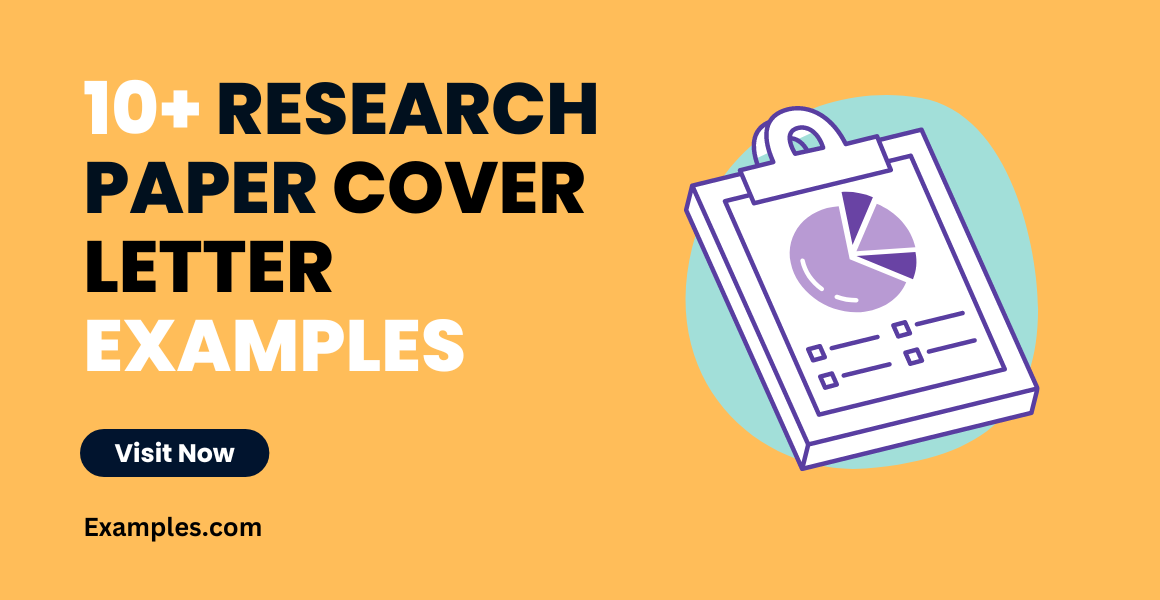
A research paper cover letter is more than just an introductory note; it’s a vital aspect of your submission to academic journals. This document provides the initial impression and encapsulates the essence of your research. In this article, we will delve into what a research paper cover letter is, provide an illustrative example, and share valuable tips for crafting one that resonates with the editors.
What is a Research Paper Cover Letter?
A research paper cover letter is a formal letter accompanying the submission of a research paper to a journal or academic conference. It’s your opportunity to introduce the paper, briefly summarize the findings, highlight the significance, and persuade the editor or review panel about the paper’s importance. It’s a critical aspect of the submission process, reflecting the paper’s quality and your professionalism, so it must be thoughtfully composed.
What is an Example of a Research Paper Cover Letter?
Here is a comprehensive example of a research paper cover letter:
[Your Name] [Your Address] [City, State ZIP Code] [Email Address] [Phone Number] [Date]
[Editor’s Name] [Title] [Journal Name] [Address] [City, State ZIP Code]
Subject: Submission of Manuscript – “Exploring the Impact of AI on Environmental Sustainability”
Dear [Editor’s Name],
I am honored to submit my manuscript entitled “Exploring the Impact of AI on Environmental Sustainability” for consideration for publication in [Journal Name]. This research offers groundbreaking insights into how artificial intelligence can be harnessed for sustainable development.
The methodology includes comprehensive analysis and experimentation, and the results reveal promising opportunities in utilizing AI for ecological balance. The findings contribute to the broader understanding of technology’s role in environmental stewardship, filling a significant gap in existing literature.
I confirm that this work is original, has not been published elsewhere, and complies with all ethical guidelines. Enclosed are the manuscript, diagrams, tables, and supplementary materials as per your submission criteria.
I appreciate your consideration of this submission and eagerly await the opportunity to contribute to [Journal Name]. Please feel free to contact me for any further information.
[Your Signature]
[Your Typed Name] [Your Affiliation]
This great cover letter example articulates the crucial elements that make up an effective research paper cover letter. It introduces the topic, succinctly outlines the key points, and concludes with a respectful closure. Customizing such a letter according to the specific journal or conference’s guidelines is essential for a successful submission.
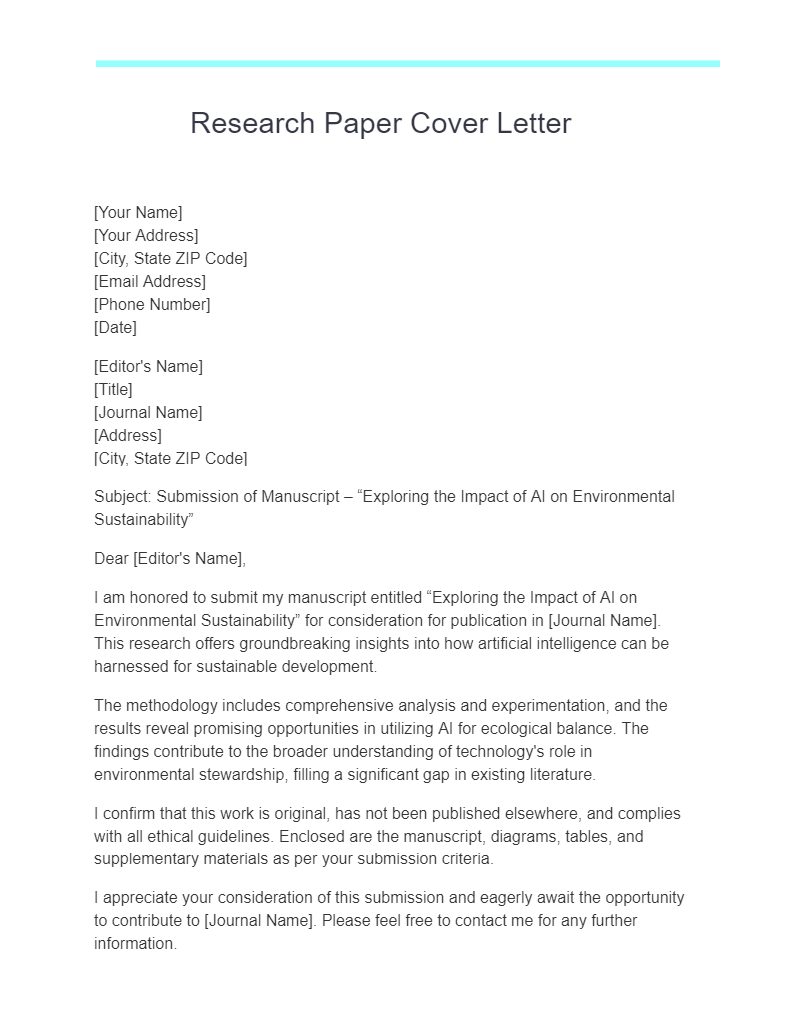
Size: 28 KB
Research Paper Cover Letter Format
Navigate the nuances of academic presentation with our Research Paper Cover Letter Format, designed to make your scholarly work stand out with professionalism and clarity.
[Your Name] [Address] [City, State ZIP Code] [Email Address] [Date]
[Editor’s Name] [Title] [Journal Name] [Address] [City, State ZIP Code]
Subject: Submission of Manuscript: “[Title of the Research Paper]”
I am pleased to submit my manuscript entitled “[Title of the Research Paper]” for potential publication in [Journal Name]. The research embodied in this paper investigates [provide a brief but comprehensive overview of the research topic, methodology, and significance].
This manuscript has not been published elsewhere and has not been submitted simultaneously for publication elsewhere. I believe that the insights and evidence presented in this paper provide a valuable contribution to the existing body of work in [specify the field or subject area].
Thank you for considering my submission. I look forward to hearing from you soon.
Sincerely, [Your Name] [Your Title] [Your Phone Number] [Your Affiliation]
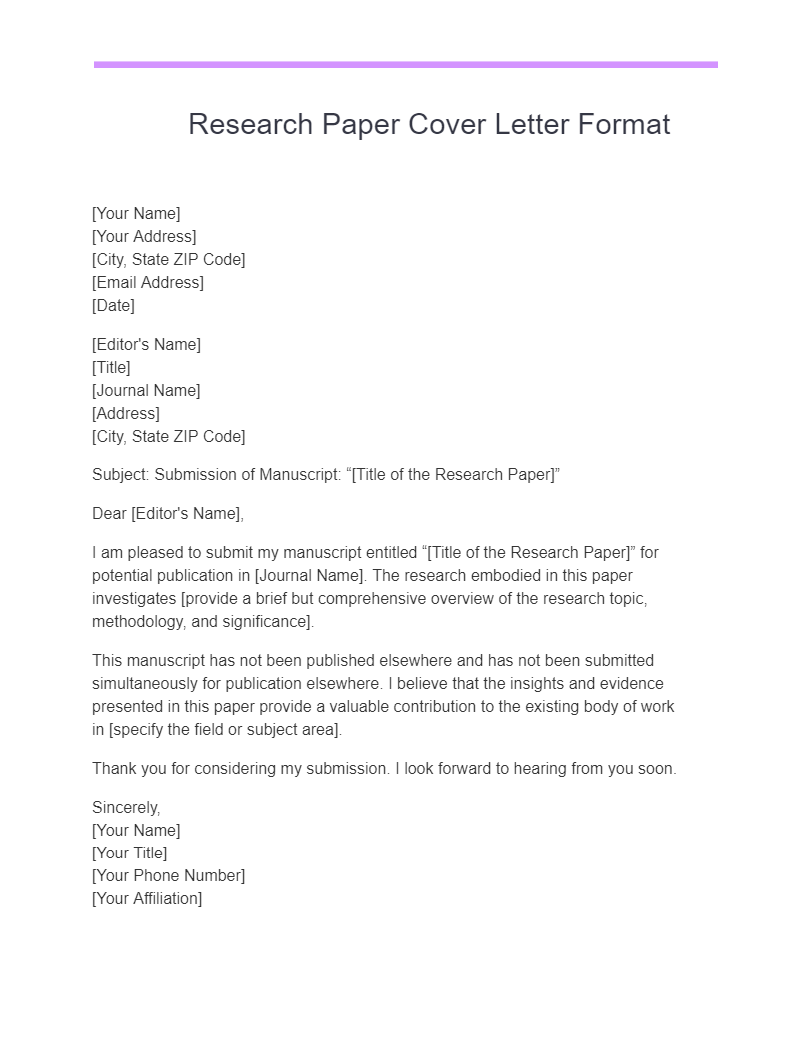
Size: 27 KB
Sample Research Paper Cover Letter Example
Access our comprehensive Sample Research Paper Cover Letter to guide your submissions, ensuring they align with academic expectations and standards.
[Your Full Name] [Your Address] [City, State, ZIP Code] [Phone Number] [Email Address] [Date]
[Professor’s Full Name] [Title] [Department] [University Name] [Address] [City, State, ZIP Code]
Subject: Submission of Research Paper on [Title]
Dear Professor [Last Name],
I am honored to submit my research paper titled “[Title of the Research Paper]” for evaluation. This paper, a key part of my [Degree Name], provides an in-depth analysis of [briefly explain the subject matter, highlighting the key themes, questions, and methodology].
Under your guidance and supervision, I have meticulously crafted this paper to reflect the highest standards of academic rigor. I am grateful for the insights and feedback you have provided throughout this process.
I look forward to your review and comments, and I am available for a meeting to discuss the paper at your convenience.
Thank you for your time and consideration.
Best Regards, [Your Full Name] [Your Student ID]
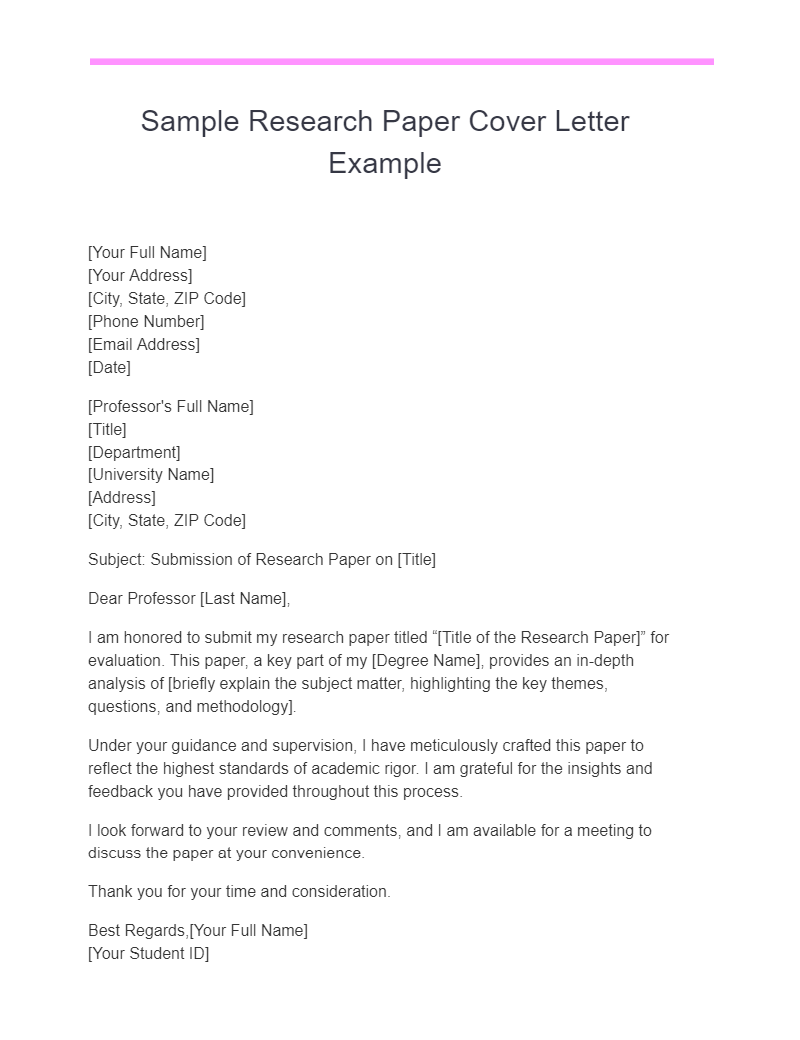
APA Style Research Paper Cover Letter Example
Master the intricacies of the APA format with our specialized cover letter, crafted to showcase your research while adhering to this authoritative style guide.
[Author’s Full Name] [Author’s Affiliation] [City, State] [Phone Number] [Email Address] [Date]
[Editor’s Name] [Title] [Journal’s Name] [Address] [City, State ZIP Code]
Subject: Submission of APA Style Research Paper: “[Title of the Paper]”
I am writing to submit my research paper for consideration in the [Journal’s Name]. The paper, titled “[Title of the Paper],” strictly adheres to the APA citation style and presents a methodological approach to [explain the central theme of the paper].
The enclosed manuscript highlights the [mention key findings, implications, or innovations]. I believe it will resonate well with the readers of [Journal’s Name] and contribute to the ongoing scholarly discourse in the field of [Field of Study].
Please find attached the manuscript along with all supplementary materials. I appreciate your consideration and await your feedback.
Sincerely, [Author’s Full Name] [Author’s Title] [Author’s Affiliation]
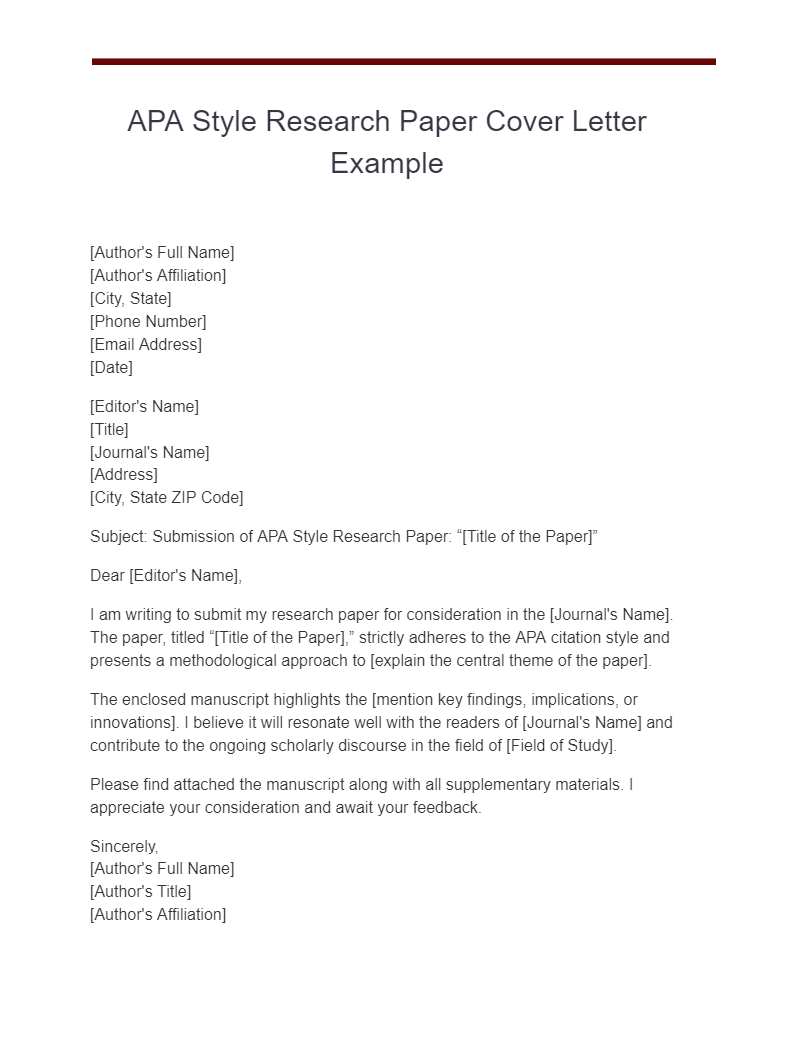
Size: 26 KB
Cover Letter for Research Project Example
Elevate your project proposals with our tailored cover letter, emphasizing the significance, methodology, and expected outcomes of your academic research.
[Your Name] [Address] [City, State ZIP Code] [Email Address] [Phone Number] [Date]
[Project Coordinator’s Name] [Title] [Organization Name] [Address] [City, State ZIP Code]
Subject: Application for [Project Title] Research Project
Dear [Project Coordinator’s Name],
I am writing to express my keen interest in the [Project Title] research project at [Organization Name]. With a strong background in [Your Field], I believe that my skills and experiences align perfectly with the project’s objectives.
I have attached my research proposal, CV, and other relevant documents for your review. My proposal outlines my approach to [briefly summarize the main focus of the research project].
Thank you for considering my application. I am eager to contribute my expertise to this exciting project and look forward to the opportunity to discuss my proposal further.
Yours sincerely, [Your Name] [Your Title] [Your Affiliation]
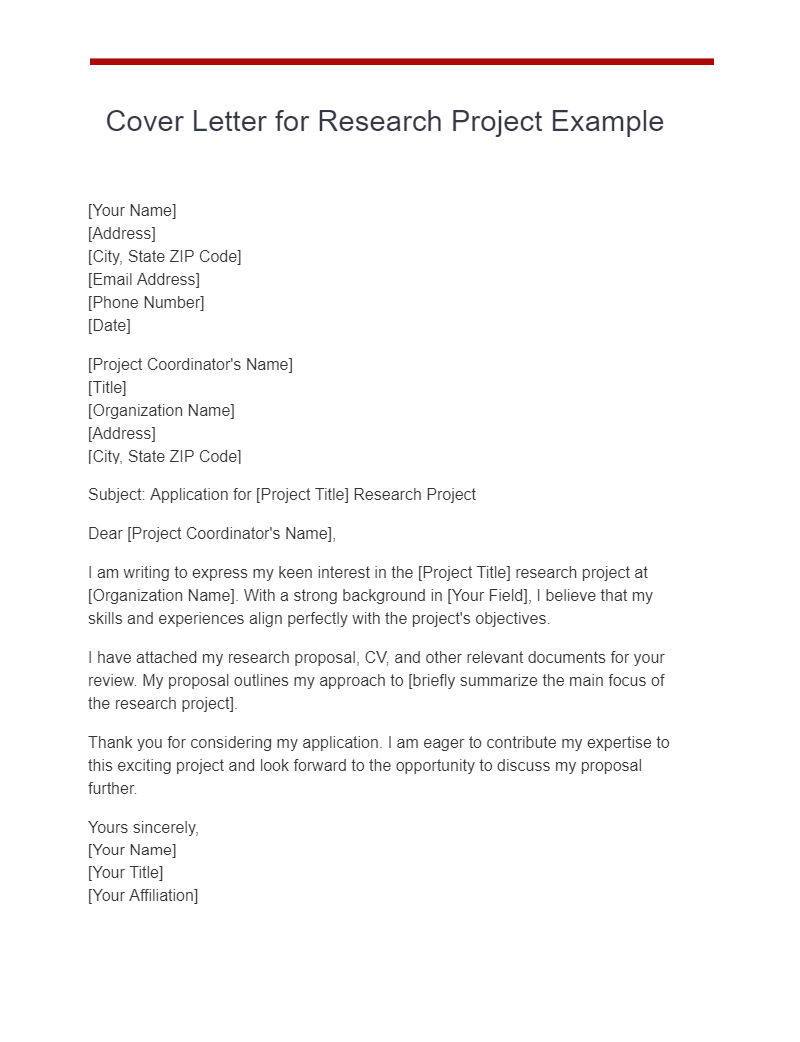
Research Paper Cover Letter for Student Example
Enhance your academic submissions with our student-focused cover letter, designed to highlight your research diligence, hypotheses, and learning objectives.
[Student’s Full Name] [Address] [City, State ZIP Code] [Email Address] [Date]
[Professor’s Full Name] [Title] [Department] [University Name] [Address] [City, State ZIP Code]
Subject: Submission of Research Paper on [Topic]
I am thrilled to submit my research paper on [Topic] as part of the requirements for [Course Name]. Through rigorous analysis, innovative methodologies, and critical thinking, I have explored [briefly summarize the subject matter of the paper].
I value the insights and guidance you provided during my research and writing process. The knowledge I gained from this experience has greatly enhanced my understanding of [Field of Study].
Thank you for your time and consideration. I look forward to your feedback.
Sincerely, [Student’s Full Name] [Student ID] [Course Name]
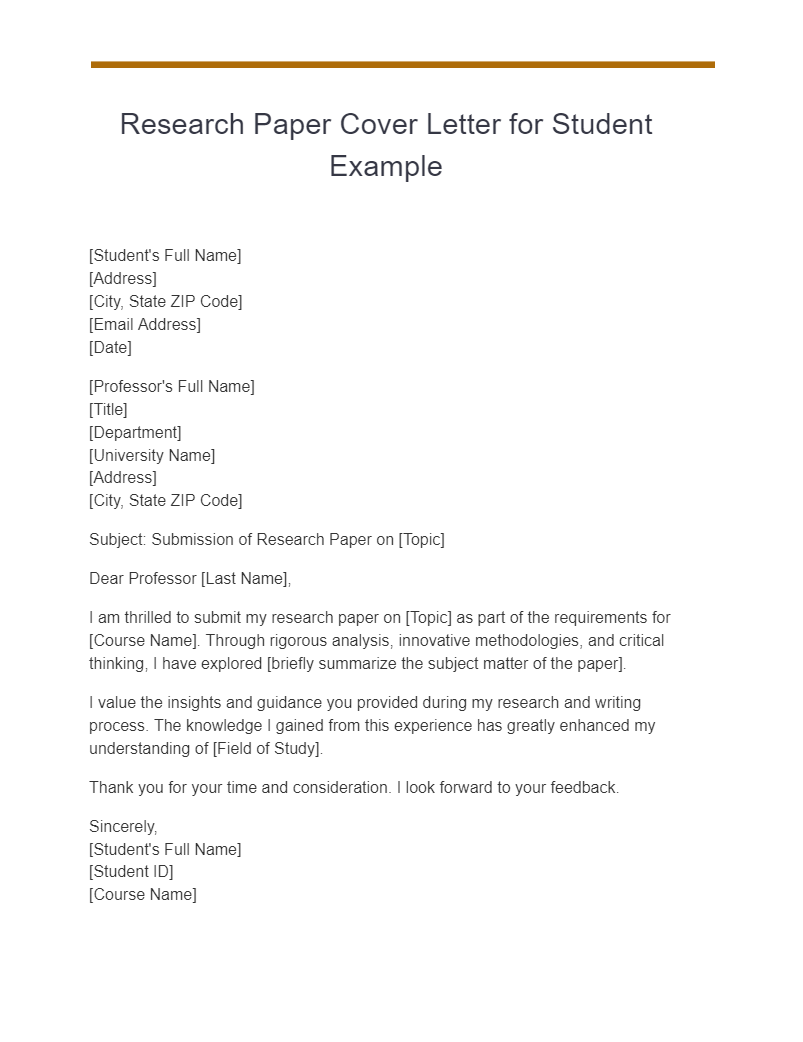
Research Paper Cover Letter for Thesis Example
Add finesse to your thesis presentation with our dedicated cover letter, underlining the depth, originality, and significance of your pivotal research.
[Your Full Name] [Address] [City, State ZIP Code] [Phone Number] [Email Address] [Date]
[Thesis Advisor’s Full Name] [Title] [Department] [University Name] [Address] [City, State ZIP Code]
Subject: Submission of Thesis Research Paper on [Topic]
Dear Dr. [Last Name],
It is with great anticipation that I submit my thesis research paper on [Topic]. This comprehensive study, guided by your expert mentorship, has been both challenging and rewarding.
I have delved deeply into [explain the central theme, methodology, and findings], aiming to contribute valuable insights to the field of [Field of Study].
Enclosed are my thesis, along with all supporting documents. I appreciate your attention to this work, and I am eager to discuss it further at your convenience.
Thank you for your time, support, and guidance.
Best Regards, [Your Full Name] [Your Student ID] [Degree Program]
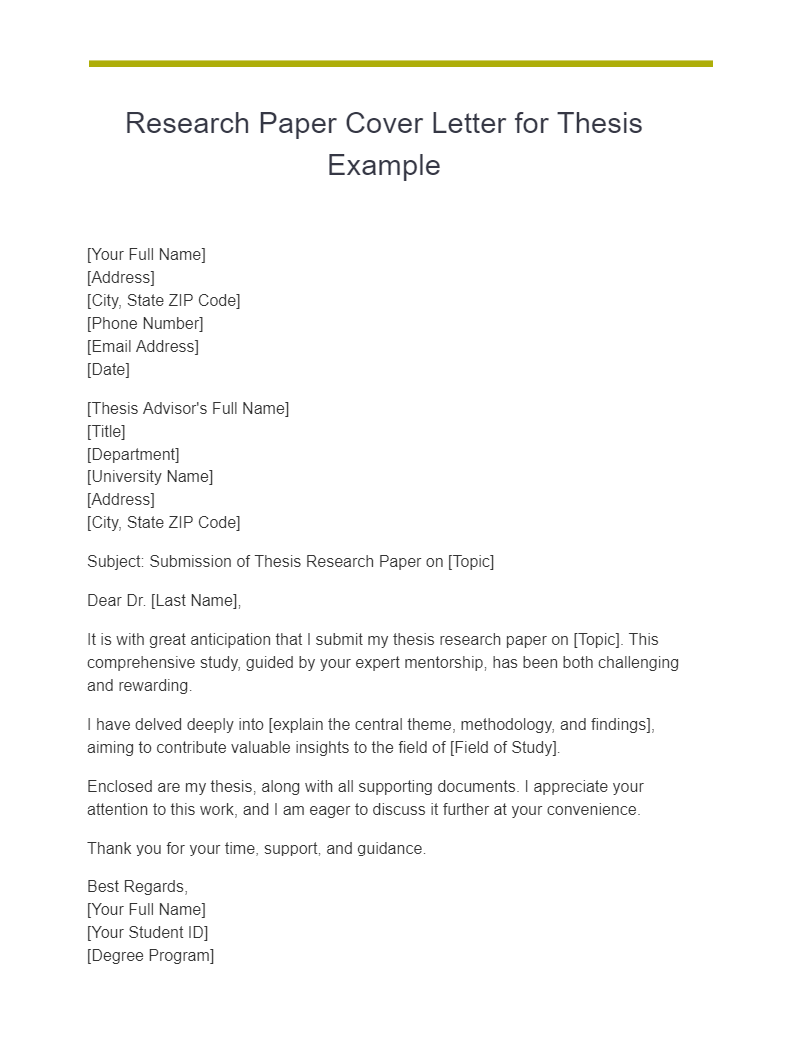
Cover Letter for Journal Submission Example
Ensure your scholarly work is compellingly presented with our Journal Submission Cover Letter, tailored to captivate editors and facilitate publication.
[Your Full Name] [Title] [Address] [City, State ZIP Code] [Email Address] [Phone Number] [Date]
[Editor’s Full Name] [Title] [Journal Name] [Address] [City, State ZIP Code]
Subject: Manuscript Submission for [Journal Name]: “[Title of Research Paper]”
Dear Dr. [Editor’s Last Name],
I am pleased to submit my manuscript, titled “[Title of Research Paper],” for potential publication in [Journal Name]. This original research contributes to the field of [Field of Study] by [provide a concise overview of the paper’s central theme, methodology, and key findings].
I have followed all the guidelines provided by [Journal Name] and have included all necessary supplementary materials.
Thank you for considering my submission. I believe this research fits well with the focus of your esteemed journal, and I look forward to your response.
Sincerely, [Your Full Name] [Your Title] [Your Affiliation]

Simple Research Paper Cover Letter Example
Go for a minimalist yet impactful approach with our Simple Research Paper Cover Letter, designed to present your findings clearly and concisely.
[Recipient’s Full Name] [Title] [Organization Name] [Address] [City, State ZIP Code]
Subject: Submission of Research Paper: “[Title]”
Dear [Recipient’s First Name],
I am delighted to submit my research paper on [Title]. This paper, written as part of my [Degree/Course], provides a comprehensive analysis of [briefly summarize the research topic and methodology].
I have enclosed the paper and all necessary supporting documents. Your review and feedback will be greatly appreciated.
Best Regards, [Your Full Name] [Your Title] [Your Affiliation]
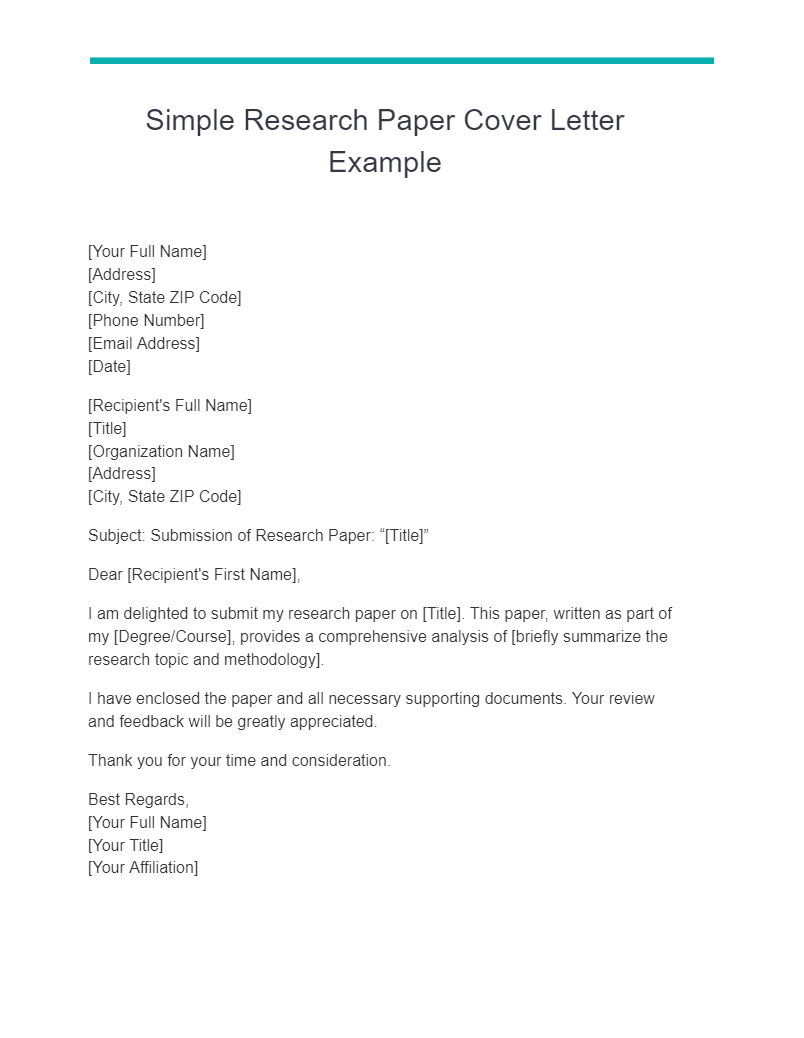
Basic Research Paper Cover Letter Example
Use our Basic Research Paper Cover Letter as a foundational guide, offering a straightforward presentation of your academic research and its implications.
[Your Full Name] [Address] [City, State ZIP Code] [Email Address] [Date]
Subject: Manuscript Submission: “[Title]”
I am submitting my manuscript titled “[Title]” for your review. This research paper delves into [briefly describe the research topic, key questions, methodology, and significance].
Enclosed are the manuscript and all necessary supporting documents. I look forward to your feedback and hope for a positive consideration.
Thank you for your time.
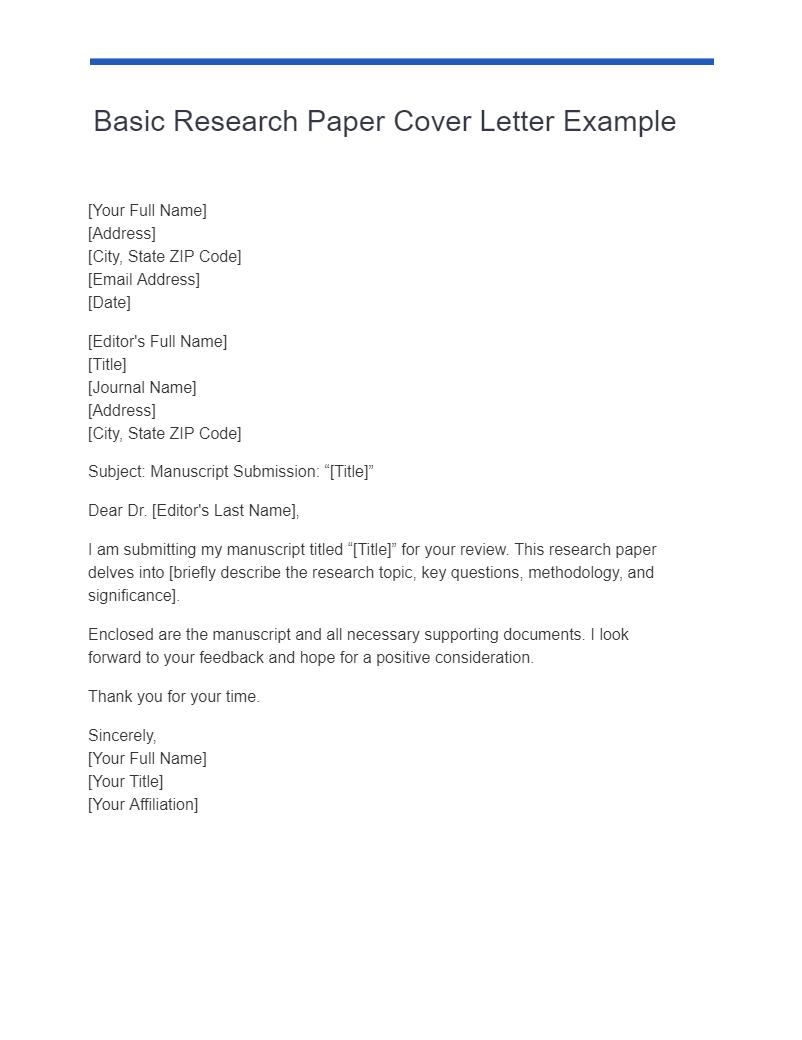
Professional Research Paper Cover Letter Example
Elevate your academic submissions with a touch of professionalism using our expertly crafted cover letter, emphasizing your research’s significance, methodology, and scholarly contribution.
Subject: Professional Submission of Research Paper: “[Research Paper Title]”
I am pleased to submit my research paper, titled “[Research Paper Title],” for professional review and potential publication in [Journal Name]. This work represents a rigorous investigation into [provide a detailed overview of the research subject, methodology, key findings, and implications].
I believe this research paper meets the high standards of your esteemed journal and will engage and inform your readership.
Please find attached the manuscript, along with all necessary supporting documents. I look forward to your review and response.
Yours Professionally, [Your Full Name] [Your Title] [Your Affiliation] [Your Phone Number]
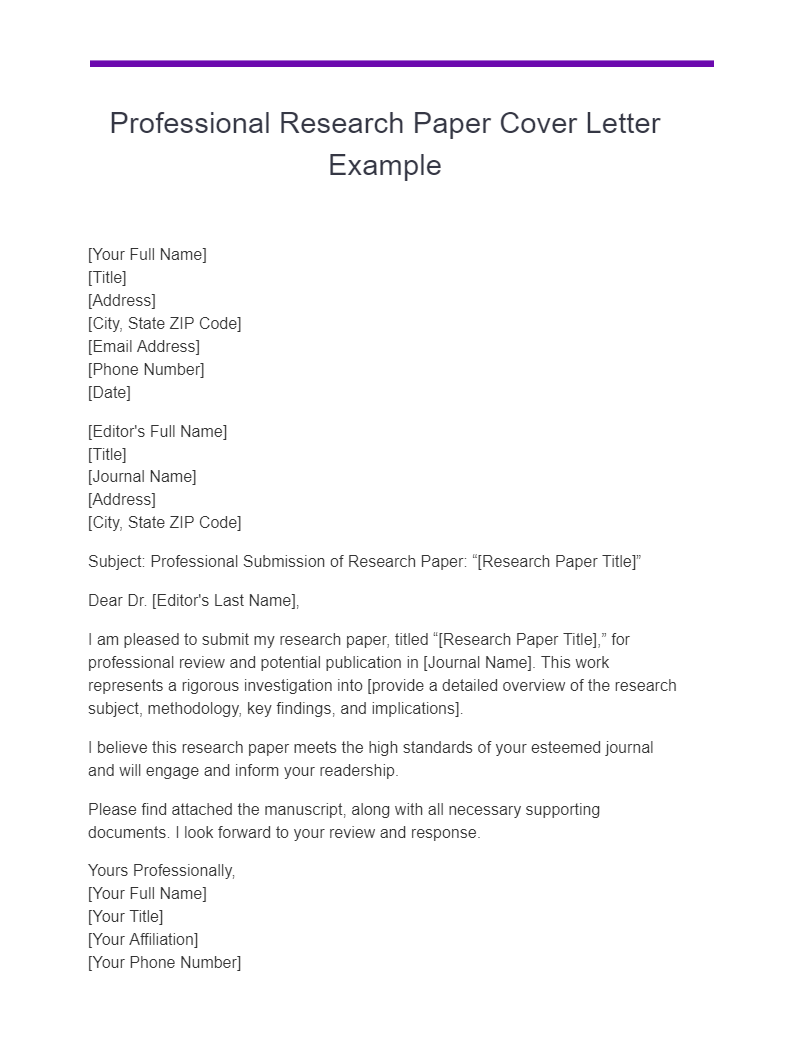
What do you write in a Research Paper Cover Letter?
A Research Paper Cover Letter serves as a formal introduction of your research to the editor, professor, or other relevant authority. It highlights key aspects of your research and reflects your professionalism. Here’s what you typically include:
1. Introduction: Introduce yourself, the title of the paper, and the purpose of the cover letter. 2. Subject of Research: Briefly explain the research topic, methodology, and main findings. 3. Relevance: Discuss the significance of your research and why it is suitable for the intended audience or journal. 4. Compliance with Guidelines: Mention adherence to the submission guidelines or specific style, like APA. 5. Exclusivity: If submitting to a journal, state that the work has not been published elsewhere. 6. Attachments: List the documents you are attaching, including the manuscript and supplementary materials. 7. Gratitude and Closing: Thank the recipient for their consideration and provide your contact information.
How Do You Write a Cover Letter for a Research Paper?
Writing a cover letter for a research paper requires care and precision. Here’s a step-by-step guide:
1. Address the Recipient Formally: Use the proper title and full name if known. If not, use a general salutation. 2. Introduce Yourself and Your Paper: Start with a concise introduction to your research and its relevance. 3. Provide a Brief Overview: Summarize the key points, methodology, and findings of your research. 4. Highlight the Significance: Explain why the paper is important and how it contributes to the field. 5. Follow Guidelines: If submitting to a journal or specific conference, adhere to their guidelines and mention your compliance. 6. Use Professional Tone and Language: Keep the language formal, clear, and error-free. 7. Include Contact Information: Provide your email, phone number, and other relevant contact details. 8. Sign Off Formally: Close with a polite and professional sign-off, such as “Sincerely,” followed by your name.
Tips for Writing a Research Paper Cover Letter
1. Understand Your Audience: Tailor the cover letter to the recipient, whether it’s a journal editor, professor, or other authority. 2. Be Concise: Keep it brief while including all necessary details. 3. Highlight Key Points: Focus on the most critical and unique aspects of your research. 4. Follow a Structure: Use a clear and organized format with distinct sections. 5. Proofread: Ensure that your cover letter is free of grammatical errors and typos. 6. Maintain Professionalism: Use a respectful tone and formal language throughout. 7. Align with the Journal or Institution’s Tone: If applicable, match the style and tone of the journal or institution to which you are submitting.
Research Paper Cover Letters play a crucial role in making a positive impression and conveying the significance of your work. By adhering to formalities and focusing on the essentials of your research, you can create an effective and professional cover letter.
Text prompt
- Instructive
- Professional
Write a cover letter for a college student applying for an internship at an educational technology company
Form a cover letter for a high school student seeking a part-time job at a local bookstore.
- SpringerLink shop
Cover letters
A good cover letter can help to “sell” your manuscript to the journal editor. As well as introducing your work to the editor you can also take this opportunity to explain why the manuscript will be of interest to a journal's readers, something which is always as the forefront editors’ mind. As such it is worth spending time writing a coherent and persuasive cover letter.
The following is an example of a poor cover letter:
Dear Editor-in-Chief, I am sending you our manuscript entitled “Large Scale Analysis of Cell Cycle Regulators in bladder cancer” by Researcher et al. We would like to have the manuscript considered for publication in Pathobiology. Please let me know of your decision at your earliest convenience. With my best regards, Sincerely yours, A Researcher, PhD
Instead, check to see whether the journal’s Instructions for Authors have any cover letter requirements (e.g. disclosures, statements, potential reviewers). Then, write a letter that explains why the editor would want to publish your manuscript. The following structure covers all the necessary points that need to be included.
- If known, address the editor who will be assessing your manuscript by their name. Include the date of submission and the journal you are submitting to.
- First paragraph: include the title of your manuscript and the type of manuscript it is (e.g. review, research, case study). Then briefly explain the background to your study, the question you sought out to answer and why.
- Second paragraph: you should concisely explain what was done, the main findings and why they are significant.
- Third paragraph: here you should indicate why the readers of the journal would be interested in the work. Take your cues from the journal’s aims and scope. For example if the journal requires that all work published has broad implications explain how your study fulfils this. It is also a good idea to include a sentence on the importance of the results to the field.
- To conclude state the corresponding author and any journal specific requirements that need to be complied with (e.g. ethical standards).
TIP: All cover letters should contain these sentences:
- We confirm that this manuscript has not been published elsewhere and is not under consideration by another journal.
- All authors have approved the manuscript and agree with its submission to [insert the name of the target journal].
Submission checklist
Before submitting your manuscript, thoroughly check its quality one more time. Evaluate it critically—could anything be done better?
Be sure that:
- The manuscript follows the Instructions for Authors
- All files are in the correct file format and of the appropriate resolution or size
- The spelling and grammar are correct
- You have contact information for all authors
- You have written a persuasive cover letter
Back │ Next
- Affiliate Program

- UNITED STATES
- 台灣 (TAIWAN)
- TÜRKIYE (TURKEY)
- Academic Editing Services
- - Research Paper
- - Journal Manuscript
- - Dissertation
- - College & University Assignments
- Admissions Editing Services
- - Application Essay
- - Personal Statement
- - Recommendation Letter
- - Cover Letter
- - CV/Resume
- Business Editing Services
- - Business Documents
- - Report & Brochure
- - Website & Blog
- Writer Editing Services
- - Script & Screenplay
- Our Editors
- Client Reviews
- Editing & Proofreading Prices
- Wordvice Points
- Partner Discount
- Plagiarism Checker
- APA Citation Generator
- MLA Citation Generator
- Chicago Citation Generator
- Vancouver Citation Generator
- - APA Style
- - MLA Style
- - Chicago Style
- - Vancouver Style
- Writing & Editing Guide
- Academic Resources
- Admissions Resources
How to Write a Cover Letter for Journal Submission
If you’re looking for solid advice on how to write a strong journal submission cover letter that will convince journal editors to review your research paper, then look no further! We know that cover letters can impact an editor’s decision to consider your research paper further.
This guide aims to explain (1) why you should care about writing a powerful cover letter, (2) what you should include in it, and (3) how you should structure it. The last segment will include a free downloadable submission cover letter template with detailed how-to explanations and some useful phrases. Finally, be sure to get journal manuscript editing , cover letter editing , and other academic editing services by Wordvice’s professional editors to ensure that you convey an academic style and error-free text, along with including all of the most important content.
Why does a good cover letter matter?
While your research paper’s role is to prove the merits of your research, a strong introductory cover letter is your opportunity to highlight the significance of your research and “sell” its concept to journal editors.
While your research paper’s role is to prove the merits of your research, a strong introductory cover letter is your opportunity to highlight the significance of your research and “sell” its concept to journal editors.
Sadly, we must admit that part of the decision-making process of whether to accept a manuscript is based on a business model. Editors must select articles that will interest their readers. In other words, your paper, if published, must make money . When it’s not quite clear how your research paper might generate interest based on its title and content alone (for example, if your paper is too technical for most editors to appreciate), your cover letter is the one opportunity you will get to convince the editors that your work is worth further review.
In addition to economic factors, many editors use the cover letter to screen whether authors can follow basic instructions . For example, if a journal’s guide for authors states that you must include disclosures, potential reviewers, and statements regarding ethical practices, failure to include these items might lead to the automatic rejection of your article, even if your research is the most progressive project on the planet! By failing to follow directions, you raise a red flag that you may be careless, and if you’re not attentive to the details of a cover letter, editors might wonder about the quality and thoroughness of your research. This is not the impression you want to give editors!
What to Include in a Cover Letter for a Journal Submission
We can’t stress this enough: Follow your target journal’s instructions for authors ! No matter what other advice you read in the vast webosphere, make sure you prioritize the information requested by the editors of the journal you are submitting to. As we explained above, failure to include required statements will lead to an automatic “ desk rejection ”.
With that said, below is a list of the most common elements you must include in your cover letter and what information you should NOT include:
Essential information:
- Editor’s name (when known)
- Name of the journal to which you are submitting
- Your manuscript’s title
- Article type (review, research, case study, etc.)
- Submission date
- Brief background of your study and the research question you sought to answer
- Brief overview of methodology used
- Principle findings and significance to scientific community (how your research advances our understanding of a concept)
- Corresponding author contact information
- Statement that your paper has not been previously published and is not currently under consideration by another journal and that all authors have approved of and have agreed to submit the manuscript to this journal
Other commonly requested information:
- Short list of similar articles previously published by the target journal
- List of relevant works by you or your co-authors that have been previously published or are under consideration by other journals. You can include copies of those works.
- Mention of any prior discussions with editor(s) (for example, if you discussed the topic with an editor at a conference)
- Technical specialties required to evaluate your paper
- Potential reviewers and their contact information
- If needed, reviewers to exclude (this information is most likely also requested elsewhere in online submissions forms)
Other disclosures/statements required by the journal (e.g., compliance with ethical standards, conflicts of interest , agreement to terms of submission, copyright sign-over, etc.)
What you should NOT do:
- Don’t use too much jargon or include too many acronyms.
- Don’t over-embellish your findings or their significance. Avoid words such as “novel,” “first ever,” and “paradigm-changing.” These types of statements show bias and will make the editor question your ability to assess your work’s merits objectively.
- Don’t name-drop. Listing people who might endorse your paper and discussing authors’ reputations do not interest editors. They want to know if your content fits their criteria, so focus solely on addressing that point.
- Don’t write a novel. While you want to adequately explain your work and sell its concept to editors, keep your cover letter to a maximum of one page. The letter is only meant to be an introduction and brief overview.
- Avoid humor . As much as we want to grab the editors’ attention, there are too many ways in which humor can go wrong!
How to Structure a Cover Letter
You should use formal language in your cover letter. Since most submissions are delivered electronically, the template below is in a modified e-mail format. However, if you send your cover letter on letterhead (PDF or hard copy by mail), move your contact information to the upper-left corner of the page unless you use pre-printed letterhead, in which case your contact information should be centered at the top of the letter.
ANNOTATED TEMPLATE Journal Submissions Cover Letter
[Journal Editor’s First and Last Name][, Graduate Degree (if any)] TIP: It’s customary to include any graduate degrees in the addressee’s name. e.g., John Smith, MD or Carolyn Daniels, MPH [Title] e.g., Editor-in-Chief, Managing Editor, Co-Editors-in-Chief [Journal Name] [Journal Address] [Submission Date: Month Day, Year]
Dear Dr./Mr./Ms. [Editor’s last name]:
TIP: Where the editor’s name is not known, use the relevant title employed by the journal, such as “Dear Managing Editor:” or “Dear Editor-in-Chief:”. Using a person’s name is best, however.
TIP: Use “Ms.” and never “Mrs.” or “Miss” in formal business letters.
TIP: Never use “Dear Sirs:” or any similar expression. Many editors will find this insulting, especially given that many of them are female!
[Para.1: 2–3 sentences] I am writing to submit our manuscript entitled, [“Title”] for consideration as a [Journal Name][Article Type]. [One to two sentence “pitch” that summarizes the study design, where applicable, your research question, your major findings, and the conclusion.]
e.g., I am writing to submit our manuscript entitled, “X Marks the Spot” for consideration as an Awesome Science Journal research article. We examined the efficacy of using X factors as indicators for depression in Y subjects in Z regions through a 12-month prospective cohort study and can confirm that monitoring the levels of X is critical to identifying the onset of depression, regardless of geographical influences.
TIP: Useful phrases to discuss your findings and conclusion include:
- Our findings confirm that…
- We have determined that…
- Our results suggest…
- We found that…
- We illustrate…
- Our findings reveal…
- Our study clarifies…
- Our research corroborates…
- Our results establish…
- Our work substantiates…
[Para. 2: 2–5 sentences] Given that [context that prompted your research], we believe that the findings presented in our paper will appeal to the [Reader Profile] who subscribe to [Journal Name]. Our findings will allow your readers to [identify the aspects of the journal’s Aim and Scope that align with your paper].
TIP: Identify the journal’s typical audience and how those people can utilize your research to expand their understanding of a topic. For example, if many of your target journal’s readers are interested in the public policy implications of various research studies, you may wish to discuss how your conclusions can help your peers to develop stronger policies that more effectively address public concerns.
TIP: Include context about why this research question had to be addressed.
e.g., “Given the struggle policymakers have had to define proper criteria to diagnose the onset of depression in teenagers, we felt compelled to identify a cost-effective and universal methodology that local school administrators can use to screen students.”
TIP: If your paper was prompted by prior research, state this. For example, “After initially researching X, Y approached us to conduct a follow-up study that examined Z. While pursuing this project, we discovered [some new understanding that made you decide the information needed to be shared with your peers via publication.]”
e.g., Given the alarming increase in depression rates among teenagers and the lack of any uniform practical tests for screening students, we believe that the findings presented in our paper will appeal to education policymakers who subscribe to The Journal of Education . Although prior research has identified a few methods that could be used in depression screening, such as X and Y, the applications developed from those findings have been cost-prohibitive and difficult to administer on a national level. Thus, our findings will allow your readers to understand the factors involved in identifying the onset of depression in teenagers better and develop more cost-effective screening procedures that can be employed nationally. In so doing, we hope that our research advances the toolset needed to combat the concerns preoccupying the minds of many school administrators.
[Para 3: Similar works] “This manuscript expands on the prior research conducted and published by [Authors] in [Journal Name]” or “This paper [examines a different aspect of]/ [takes a different approach to] the issues explored in the following papers also published by [Journal Name].”
TIP: You should mention similar studies recently published by your target journal, if any, but list no more than five. If you only want to mention one article, replace the preceding sentence with “This paper [examines a different aspect of]/ [takes a different approach to] the issues explored by [Authors] in [Article Title], also published by [Journal Name] on [DATE].”
[Para. 4: Additional statements often required] Each of the authors confirms that this manuscript has not been previously published and is not currently under consideration by any other journal. Additionally, all of the authors have approved the contents of this paper and have agreed to the [Journal Name]’s submission policies.
TIP: If you have previously publicly shared some form or part of your research elsewhere, state so. For example, you can say, “We have presented a subset of our findings [at Event]/ [as a Type of Publication Medium] in [Location] in [Year].”
e.g., We have since expanded the scope of our research to contemplate international feasibility and acquired additional data that has helped us to develop a new understanding of geographical influences.
[Para. 5: Potential Reviewers] Should you select our manuscript for peer review, we would like to suggest the following potential reviewers/referees because they would have the requisite background to evaluate our findings and interpretation objectively.
- [Name, institution, email, expertise]
To the best of our knowledge, none of the above-suggested persons have any conflict of interest, financial or otherwise.
TIP: Include 3–5 reviewers since it is likely that the journal will use at least one of your suggestions.
TIP: Use whichever term (“reviewer” or “referee”) your target journal uses. Paying close attention to a journal’s terminology is a sign that you have properly researched the journal and have prepared!
[Para. 6: Frequently requested additional information] Each named author has substantially contributed to conducting the underlying research and drafting this manuscript. Additionally, to the best of our knowledge, the named authors have no conflict of interest, financial or otherwise.
[Your Name]
Corresponding Author Institution Title Institution/Affiliation Name [Institution Address] [Your e-mail address] [Tel: (include relevant country/area code)] [Fax: (include relevant country/area code)]
Additional Contact [should the corresponding author not be available] Institution Title Institution/Affiliation Name [Institution Address] [Your e-mail address] [Tel: (include relevant country/area code)] [Fax: (include relevant country/area code)]
Quick Cover Letter Checklist Before Submission
- Set the font to Arial or Times New Roman, size 12 point.
- Single-space all text.
- Use one line space between body paragraphs.
- Do not indent paragraphs.
- Keep all text left justified.
- Use spelling and grammar check software. If needed, use a proofreading service or cover letter editing service such as Wordvice to review your letter for clarity and concision.
- Double-check the editor’s name. Call the journal to confirm if necessary.
Writing a Cover Letter for Journal Submission [Free Template]
- Research Process
- Peer Review
Journal cover letters are your chance to lobby on behalf of your manuscript. This AJE Journal Cover Letter Guide offers some useful tips for getting them right. It also includes a free journal cover letter template.
Updated on September 20, 2018

The cover letter accompanying your journal submission is your chance to lobby on behalf of your manuscript. The letter is far from just a formality and should be written with the same care as your manuscript's text (if not more). Ultimately, your cover letter is designed to influence the decision of the editor to send your manuscript out for peer review. The letter will argue that your manuscript is a good fit for the journal you are submitting it to and highlight your most important findings. Let us help you produce the most effective cover letter possible.
Getting ready to submit your manuscript? Download our comprehensive Free Journal Cover Letter Writing Guide with Template .
A cover letter should be written like a standard business letter :
Address the editor formally by name, if known. Include your contact information, as well. This information is probably available through the journal's online submission system, but it is proper to provide it in the cover letter, too.
Begin your cover letter with a paragraph that states the name of the manuscript and the names of the authors. You can also describe what type of manuscript your submission is (research article, review, case report, etc.). In this first paragraph and the next, describe the rationale behind your study and the major findings from your research. You can refer to prior work that you have published if it is directly related.
Next, write a short paragraph that explains why your manuscript would be a good fit for the journal. Do not simply state that your manuscript is “of interest to the field” or “novel.” Address specific aspects of the journal's Aims & Scope statement. If the journal expresses interest in research with a clinical application, be sure to highlight the importance of your work in terms of clinical implications. If the journal mentions that it focuses on nanostructured materials, explain how your work involved such materials. Even if your work is not a perfect fit for the journal, be sure to address some of the Aims & Scope statement, and explain why your manuscript would be of interest to the journal's readers.
Finally, close with a brief paragraph indicating the following:
- The manuscript is original (i.e., you wrote it, not copied it)
- No part of the manuscript has been published before, nor is any part of it under consideration for publication at another journal
- There are no conflicts of interest to disclose
- A list of potential reviewers (only if requested by the journal)
- Any researchers who should NOT review your manuscript
Together, this information provides assurance to the editor that your manuscript merits consideration for publication in their journal and that you are interested specifically in their journal. Sometimes great science will be reviewed regardless of the cover letter, but a well written cover letter is useful for the vast majority of scientists who want to make their research stand out.
Best of luck with your research! If you have any questions about your cover letter, write us anytime.

Ben Mudrak, PhD
See our "Privacy Policy"
Cover Letter for Journal Submission Templates
Download a Microsoft Word template for a standard journal cover letter (also available with instructions in Chinese , Japanese , Korean , Portuguese , and Spanish ).
How to Write an Effective Cover Letter for Journal Submission
Craft your cover letter for journal submission the right way with our expert tips! Learn how to grab editors’ attention and stand it out.
When it comes to submitting a manuscript for publication in a journal, many authors focus solely on the quality of their research and the clarity of their writing. While these are important factors, it’s easy to overlook the role that a well-crafted cover letter can play in the submission process. A cover letter can be the key to getting your manuscript noticed by the editor and ultimately accepted for publication. In this article, we’ll explore the importance of a cover letter for journal submissions and provide tips for crafting an effective one.
What is a Cover Letter for Journal Submission?
A cover letter for journal submission is a document that accompanies a manuscript when it is submitted for publication in an academic or scientific journal. The purpose of the cover letter is to introduce the author and their work to the editor of the journal and to provide any additional information that may be relevant to the manuscript or the submission process. Furthermore, its purpose is to introduce the manuscript to the editor and provide additional information about the research and its significance. The cover letter should be concise and focused, typically no more than one page.
What Should be Included in the Cover Letter?
A cover letter should include several key elements to effectively introduce your manuscript. It’s important to personalize the letter for the specific journal, use a professional tone, and proofread carefully for errors. To make sure your cover letter is effective, there are several key elements that you should include:
Addressee’s Information and Date of Submission
Your cover letter should start with the date of submission, followed by the name and address of the editor or editorial staff who will be reviewing your manuscript. This information should be current and accurate to ensure your submission is directed to the right person.
Opening Salutation
The opening salutation of your cover letter should be professional and courteous, addressing the editor or editorial staff by name, starting with “Dear…”. Don´t forget to include the title and position of the editor you are addressing.
Purpose Statement and Administrative Information
Your cover letter should have a clear statement of the purpose of your research and the journal to which you are submitting your manuscript. You should also include any administrative information required by the journal, such as the type of manuscript (e.g. original research, review article, case report) and the number of words or pages.
Summary of Main Research Findings and Implications
One of the most important elements of your cover letter is a summary of the main findings and implications of your research. This summary should be concise and focused, highlighting the most important aspects of your research and why it is significant to the field.
Statements or Information Required by the Journal
Many journals require specific statements or information to be included in the cover letter. This may include a statement that the manuscript has not been previously published or is not under consideration for publication elsewhere, or a list of potential conflicts of interest or funding sources that may have influenced the research.
Previous Contact with the Journal
If you have had previous contact with the journal, such as submitting a previous manuscript or attending a conference sponsored by the journal, it is important to mention this in your cover letter. This information can help establish a connection between you and the editor, which may increase the chances of your manuscript being accepted.
Conflict of Interests and Financial Disclosures
It is important to disclose any potential conflicts of interest or financial disclosures that may have influenced the research. This information can help ensure transparency and maintain the integrity of the research.
Your cover letter should include a statement indicating that all authors have read and approved the manuscript and that the work is original and not plagiarized. This information can help establish the credibility of the research and the integrity of the authorship.
Suggested Reviewers
Suggested Reviewers are generally considered a best practice and are often recommended by journals. Providing a list of suggested reviewers can help to ensure that the manuscript is reviewed by individuals who have the appropriate expertise and background to evaluate the work, and can help to speed up the review process by reducing the time needed for the editor to identify potential reviewers. This can help expedite the review process and increase the likelihood of your manuscript being accepted.
Concurrent/Duplicate Submissions
An important consideration when submitting a manuscript for publication is concurrent or duplicate submissions. Concurrent submissions occur when a manuscript is submitted to more than one journal at the same time. Duplicate submissions occur when a manuscript is submitted to the same journal more than once.
In the cover letter, you should clearly state whether the manuscript has been submitted elsewhere or whether it has been previously published. If the manuscript is under consideration elsewhere, you should provide the name of the journal and the date of submission. If the manuscript has been previously published, you should provide the citation for the publication.
Closing Salutation
When closing a cover letter for journal submission, it’s important to maintain a professional and courteous tone. A common closing salutation is “Sincerely,” followed by your name. However, some alternatives that are also appropriate include “Best regards,” “Thank you for your time and consideration,” or “Respectfully.” Whichever salutation you choose, make sure it matches the tone of your letter and conveys your appreciation for the editor’s consideration.
Request to Exclude Reviewers
A request to exclude reviewers is a common feature of a cover letter for journal submission, particularly in cases where the author has concerns about potential conflicts of interest or bias that could affect the review process.
When making a request to exclude reviewers, the author should provide a clear and concise explanation of the reasons for the request and should provide specific details about any potential conflicts of interest or concerns that they may have. It is also important to note that some journals may have specific guidelines or policies regarding requests to exclude reviewers, and authors should familiarize themselves with these guidelines before making a request.
In general, it is recommended that authors provide a minimum of three to five potential reviewers who are not affiliated with the author or their institution, in order to provide a broad range of expertise and perspectives. When making a request to exclude reviewers, it is also important to provide alternative suggestions for potential reviewers who could be considered in their place.
Tips for Writing a Journal Submission Cover Letter
A well-crafted cover letter can help your manuscript stand out and increase your chances of being accepted for publication. Here are some tips for writing an effective journal submission cover letter.
One of the most important tips for writing a journal submission cover letter is to proofread it carefully. Typos, spelling errors, and grammatical mistakes can detract from the professional image you want to project. Make sure to read the letter multiple times and have someone else read it over as well to catch any errors you may have missed.
Keep the Cover Letter Brief
Another important tip is to keep the cover letter brief and to the point. The cover letter should provide a brief introduction of the manuscript and the key findings, as well as any other information that is necessary for the editor to understand the importance and relevance of the manuscript. The letter should be no more than one page in length.
Review Examples of Cover Letters
It can be helpful to review examples of cover letters for journal submissions to get an idea of the style, tone, and content that is appropriate. You can search for examples online or ask colleagues who have submitted manuscripts for publication for their advice. When reviewing examples, pay attention to the language used, the level of detail provided, and the overall organization and structure of the letter. This can help you craft a cover letter that is professional, informative, and effective.
Cover Letter Template for a Journal Article Submission
A cover letter is an important component of manuscript submission for publication in a journal. Using a template can help ensure that your cover letter includes all the necessary information and follows the proper format. Here is a guide to creating a cover letter template for a journal article submission.
The header should include your contact information, including your name, affiliation, and contact details (address, phone number, and email address), the date of submission, and the name and address of the journal.
Opening Paragraph
The opening paragraph should provide a brief introduction to the manuscript and its key findings. This paragraph should also mention the purpose of the manuscript and why it is relevant to the journal’s readership. You may also want to mention any previous correspondence or contact with the journal.
Body Paragraphs
The body of the cover letter should include several paragraphs that provide more detail about the manuscript. This may include a summary of the methods used, key results and findings, and implications for future research. You may also want to mention any notable limitations or challenges encountered during the research process.
It is also important to address any specific requirements or requests from the journal, such as a particular format for tables or figures, or specific information to be included in the manuscript. You should also mention any funding sources or conflicts of interest that may be relevant.
Closing Paragraph
The closing paragraph should reiterate the significance of the manuscript and its contribution to the field. You may also want to mention any potential reviewers for the manuscript or suggest reviewers who would be appropriate. Finally, you should include a polite and professional closing, such as “Sincerely” or “Best regards”, followed by your name and signature.

Common Expressions for Cover Letters
When writing a cover letter for journal submission, it’s important to use appropriate and professional language. Here are some common expressions that can be used in cover letters:
“We are pleased to submit our manuscript…”
“The research reported in this manuscript addresses a significant gap in the literature…”
“We believe this manuscript will be of interest to your readership because…”
“Our findings have important implications for future research in this field.”
“We would like to thank the reviewers and editors for their time and consideration.”
“We look forward to hearing from you regarding the status of our manuscript.”
“Thank you for your time and consideration.”
These expressions can be used to convey important information in a professional and concise manner. When using these expressions, it’s important to tailor them to the specific journal and to make sure they are appropriate for the content of your cover letter.
Journal Submission Tips and Hacks from the Experts
Submitting a journal article can be a challenging and sometimes frustrating process. However, by following some tips and hacks from the experts, you can increase your chances of success. Here are some tips and hacks to help you submit your article to a journal:
Choose the Right Journal
Before submitting your article, make sure you choose the right journal. Consider factors such as the journal’s scope, readership, and impact factor. Make sure your article fits with the journal’s focus and aims.
Read the Guidelines
Read the journal’s submission guidelines carefully and follow them closely. Pay attention to formatting, length, and other requirements. Failure to follow the guidelines could result in your article being rejected without review.
Get Feedback
Before submitting your article, get feedback from colleagues or mentors. Ask them to read your manuscript and provide constructive criticism. This can help you identify potential weaknesses and improve the quality of your article.
Write a Strong Abstract
Your abstract is often the first thing that editors and reviewers will read. Make sure it is clear, concise, and provides a compelling summary of your article. Highlight the key findings and implications of your research.
Use Clear and Concise Language
Use clear and concise language when writing your article. Avoid jargon, technical terms, and complex language that could be difficult for readers to understand. Write in a way that is accessible to a broad audience.
Address Reviewer Comments
If your article is rejected or requires revisions, make sure you carefully address all reviewer comments. Be thorough and professional in your responses. This can increase your chances of acceptance in future rounds of review.
Keep Records
Keep records of all correspondence with the journal, including submission dates, reviewer comments, and decisions. This can help you stay organized and keep track of the progress of your article.
High Impact And Greater Visibility For Your Work
Mind the Graph is an innovative platform designed to help scientists create high-impact visuals and increase the visibility of their work. With its user-friendly interface, customizable templates, and vast library of scientific illustrations. Mind the Graph provides scientists with a powerful tool to help them communicate their research more effectively.

Subscribe to our newsletter
Exclusive high quality content about effective visual communication in science.
Unlock Your Creativity
Create infographics, presentations and other scientifically-accurate designs without hassle — absolutely free for 7 days!
Content tags
- Extremes and Natural Hazards
- Adaptation Science
- Earth Data Across Scales
- Earth Data Science Education
- Earth Analytics
- Landscape Dynamics
- Partnerships
- Earth Analytics Professional Certificate
- Environmental Data Science Seminar Series
- Post Docs and Graduate Students
- Earth Data Science Corps
- How to Engage
- Learning Portal
How to Write a Good Cover Letter for a Research Position
Writing a cover letter can be intimidating, but it doesn’t have to be!
Some people believe cover letters are a science. Others seem to think they are more akin to black magic. Regardless of how you feel about cover letters, they are one of the most important parts of the job application process. Your resume or CV may get you an interview, but a good cover letter is what ensures that the hiring manager reads your resume in the first place.
Writing a cover letter for any job is important, but the art of writing a good cover letter for a research position can make or break your application. While writing a cover letter for a research position, you have to walk a fine line of proving your expertise and passion while limiting jargon and dense language.
In this post, we will explain cover letter writing basics, and then dive into how to write a research specific cover letter with examples of both good and bad practices.

What Is A Cover Letter and Why Do Cover Letters Matter?
A cover letter is your opportunity to tell a story and connect the dots of your resume. Resumes and curriculum vitae (CVs) are often cold and static—they don’t show any sort of character that will give companies a hint about if you will fit in with their culture.
Your cover letter gives you the chance to demonstrate that you are an interesting, qualified, and intelligent person. Without proving that you are worth the time to interview, a company or research organization will set your application in the rejection pile without giving it a second look.
So, what is a cover letter, exactly? It is an explanation (written out in paragraph form) of what you can bring to the company that goes beyond the information in your resume. Cover letters give a company a glimpse into the qualities that will make you the ideal candidate for their opening.
Note that a cover letter is not the same as a letter of intent. A cover letter is written for a specific job opening. For example, if I got an email saying that the University of Colorado was looking for a tenure track faculty member to teach GEO 1001, and I chose to apply, I would write a cover letter.
A letter of intent, however, is written regardless of the job opening. It is intended to express an interest in working at a particular company or with a particular group. The goal of a letter of intent is to demonstrate your interest in the company (or whatever type of group you are appealing to) and illustrate that you are willing to work with them in whatever capacity they feel is best.
For example, if I loved the clothing company, Patagonia and wanted to work there, I could write a letter of intent. They may have an opening for a sales floor associate, but after reading my application and letter of intent, decide I would be better suited to a design position. Or, they may not have any positions open at all, but choose to keep my resume on hand for the next time they do.
Most organizations want a cover letter, not a letter of intent, so it is important to make sure your cover letter caters to the specifics of the job posting. A cover letter should also demonstrate why you want to work at the company, but it should be primarily focused on why you can do the job better than any of the other applicants.
How to Write a Good Cover Letter: The Basics
Writing a cover letter isn’t hard. Writing a good cover letter, a cover letter that will encourage a hiring manager to look at your application and schedule an interview, is more difficult (but certainly not impossible). Below, we will go over each of the important parts of a cover letter: the salutation, introduction, body, and conclusion, as well as some other best practices.
How to Write a Good Cover Letter Salutation
Don’t start with “Dear Sir/Ma’am” (or any iteration of a vague greeting, including “to whom it may concern”). Avoiding vague greetings is the oldest trick in the book, but it still holds a lot of weight. Starting a cover letter with the above phrase is pretty much stamping “I didn’t bother to research this company at all because I am sending out a million generic cover letters” across your application. It doesn’t look good.
The best practice is to do your research and use your connections to find a name. “Dear Joe McGlinchy” means a lot more than “Dear Hiring Manager.” LinkedIn is a great tool for this—you can look up the company, then look through the employees until you find someone that seems like they hire for the relevant department.
The most important thing about the salutation is to address a real human. By selecting someone in the company, you’ve demonstrated that you’ve done some research and are actually interested in this company specifically. Generic greetings aren’t eye-catching and don’t do well.
How to Write a Good Cover Letter Introduction
Once you’ve addressed your cover letter to a real human being, you need a powerful introduction to prove that this cover letter is worth the time it will take to read. This means that you need a hook.
Your first sentence needs to be a strong starter, something to encourage the hiring manager not only to continue reading the cover letter, but to look at your application as well. If you have a contact in the company, you should mention them in the first sentence. Something along the lines of “my friend, Amanda Rice (UX/UI manager), suggested I apply for the natural language processing expert position after we worked together on a highly successful independent project.”
The example above uses a few techniques. The name drop is good, but that only works if you actually have a connection in the company. Beyond that, this example has two strengths. First, it states the name of the position. This is important because hiring managers can be hiring for several different positions at a time, and by immediately clarifying which position you are applying for, you make their job a little bit easier. Next, this sentence introduces concrete skills that apply to the job. That is a good way to start because it begins leading into the body, where you will go into depth about how exactly your experience and skills make you perfect for the job.
Another technique for a strong lead-in to a cover letter is to begin with an applicable personal experience or anecdote. This attracts more attention than stereotypical intros (like the example above), but you have to be careful to get to the point quickly. Give yourself one or two sentences to tell the story and prove your point before you dive into your skills and the main body of the cover letter.
A more standard technique for introductions is simply expressing excitement. No matter how you choose to start, you want to demonstrate that you are eager about the position, and there is no easier way to do that than just saying it. This could take the form of “When I saw the description for X job on LinkedIn, I was thrilled: it is the perfect job for my Y skills and Z experience.” This option is simple and to-the-point, which can be refreshing for time-crunched hiring managers.
Since we’ve provided a few good examples, we will offer a bad example, so you can compare and contrast. Don’t write anything along the line of: “My name is John Doe, and I am writing to express my interest in the open position at your company.”
There are a few issues here. First, they can probably figure out your name. You don’t need that to be in the first sentence (or any of the sentences—the closing is an obvious enough spot). Next, “the open position” and “your company” are too generic. That sounds like the same cover letter you sent to every single employer in a hundred mile radius. Give the specifics! Finally, try to start with a little more spice. Add in some personality, something to keep the hiring manager reading. If you bore them to death in the first line, they aren’t going to look over your resume and application with the attention they deserve.
How to Write a Good Cover Letter Body
So, you’ve addressed a real human being, and you’ve snagged their attention with a killer opening line. What next? Well, you have to hold on to that attention by writing an engaging and informative cover letter body.
The body of a cover letter is the core of the important information you want to transmit. The introduction’s job was to snag the attention of the hiring manager. The body’s job is to sell them on your skills. There are a few formatting things to be aware of before we start talking about what content belongs in the body of the cover letter. First, keep the company culture and standards in mind when picking a format. For example, if I want to work for a tech startup that is known for its wit and company culture, I can probably get away with using a bulleted list or another informal format. However, if I am applying to a respected research institution, using a standard five paragraph format is best.
In addition, the cover letter should not be longer than a page. Hiring managers are busy people. They may have hundreds of resumes to read, so they don’t need a three page essay per person. A full page is plenty, and many hiring managers report finding three hundred words or less to be the idea length. Just to put that into context, the text from here to the “How to Write a Good Cover Letter Body” header below is about perfect, length-wise.
Now, on to the more important part: the content. A cover letter should work in tandem with a resume. If you have a list of job experiences on your resume, don’t list them again in the cover letter. Use the valuable space in the cover letter to give examples about how you have applied your skills and experience.
For example, if I have worked as a barista, I wouldn’t just say “I have worked as a barista at Generic Cafe.” The hiring manager could learn that from my resume. Instead, I could say “Working as a barista at Generic Cafe taught me to operate under pressure without feeling flustered. Once…” I would go on to recount a short story that illustrated my ability to work well under pressure. It is important that the stories and details you choose to include are directly related to the specific job. Don’t ramble or add anything that isn’t obviously connected. Use the job description as a tool—if it mentions a certain skill a few times, make sure to include it!
If you can match the voice and tone of your cover letter to the voice of the company, that usually earns you extra points. If, in their communications, they use wit, feel free to include it in your letter as well. If they are dry, to the point, and serious, cracking jokes is not the best technique.
A Few Don’ts of Writing a Cover Letter Body
There are a few simple “don’ts” in cover letter writing. Do not:
- Bad: I am smart, dedicated, determined, and funny.
- Better: When I was working at Tech Company, I designed and created an entirely new workflow that cut the product delivery time in half.
- Bad: When I was seven, I really loved the monkeys at the zoo. This demonstrates my fun-loving nature.
- Better: While working for This Company, I realized I was far more productive if I was light-hearted. I became known as the person to turn to in my unit when my coworkers needed a boost, and as my team adopted my ideology, we exceeded our sales goals by 200%.
- Bad: I would love this job because it would propel me to the next stage of my career.
- Better: With my decade of industry experience communicating with engineers and clients, I am the right person to manage X team.
- Bad: I know I’m not the most qualified candidate for this job, but…
- Better: I can apply my years of experience as an X to this position, using my skills in Y and Z to…
- Bad: I am a thirty year old white woman from Denver…
- Better: I have extensive experience managing diverse international teams, as illustrated by the time I…
The most important part of the cover letter is the body. Sell your skills by telling stories, but walk the razor’s edge between saying too much and not enough. When in doubt, lean towards not enough—it is better for the hiring manager to call you in for an interview to learn more than to bore them.
How to Write a Good Cover Letter Conclusion
The last lines of a cover letter are extremely important. Until you can meet in-person for an interview, the conclusion of your cover letter will greatly affect the impression the hiring manager has of you. A good technique for concluding your cover letter is to summarize, in a sentence, what value you can bring to the company and why you are perfect for the position. Sum up the most important points from your cover letter in a short, concise manner.
Write with confidence, but not arrogance. This can be a delicate balance. While some people have gotten away (and sometimes gotten a job) with remarks like, “I’ll be expecting the job offer soon,” most do not. Closing with a courteous statement that showcases your capability and skills is far more effective than arrogance. Try to avoid trite or generic statements in the closing sentence as well. This includes the template, “I am very excited to work for XYZ Company.” Give the hiring manager something to remember and close with what you can offer the company.
The final step in any cover letter is to edit. Re-read your cover letter. Then, set it aside for a few hours (or days, time permitting) and read it again. Give it to a friend to read. Read it aloud. This may seem excessive, but there is nothing more off-putting than a spelling or grammar error in the first few lines of a cover letter. The hiring manager may power through and ignore it, but it will certainly taint their impression.
Once the cover letter is as flawless and compelling as it can be, send it out! If you are super stuck on how to get started, working within a template may help. Microsoft Word has many free templates that are aesthetically appealing and can give you a hint to the length and content. A few good online options live here (free options are at the bottom—there is no reason to pay for a resume template).
How to Write a Cover Letter for a Research Position
Writing a cover letter for a research position is the same as writing any other cover letter. There are, however, a few considerations and additions that are worth pointing out. A job description may not directly ask for a cover letter, but it is good practice to send one unless they specifically say not to. This means that even if a cover letter isn’t mentioned, you should send one—it is best practice and gives you an opportunity to expand on your skills and research in a valuable way.
Format and Writing Style for a Research Position Cover Letter
Research and academics tend to appreciate formality more than start-ups or tech companies, so using the traditional five paragraph format is typically a good idea. The five paragraph format usually includes an introduction, three short examples of skills, and a concluding paragraph. This isn’t set in stone—if you’d rather write two paragraphs about the skills and experience you bring to the company, that is fine.
Keep in mind that concise and to-the-point writing is extremely valuable in research. Anyone who has ever written a project proposal under 300 words knows that every term needs to add value. Proving that you are a skilled writer, starting in your cover letter, will earn you a lot of points. This means that cover letters in research and academia, though you may have more to say, should actually be shorter than others. Think of the hiring manager—they are plowing through a massive stack of verbose, technical, and complex cover letters and CVs. It is refreshing to find an easy to read, short cover letter.
On the “easy to read” point, remember that the hiring manager may not be an expert in your field. Even if they are, you cannot assume that they have the exact same linguistic and educational background as you. For example, if you have dedicated the last five years of your life to studying a certain species of bacteria that lives on Red-Eyed Tree Frogs, all of those technical terms you have learned (and maybe even coined) have no place in your cover letter. Keep jargon to an absolute minimum. Consider using a tool like the Hemingway Editor to identify and eliminate jargon. While you want to reduce jargon, it is still important to prove that you’ve researched their research. Passion about the research topic is one of the most valuable attributes that a new hire can offer.
Use your cover letter to prove that you have done your homework, know exactly what the institution or group is doing, and want to join them. If you have questions about the research or want to learn more, it isn’t a bad idea to get in touch with one of the researchers. You can often use LinkedIn or the group’s staff site to learn who is working on the project and reach out.

What Research Information Should be Included in a Cover Letter
A research position cover letter is not the place for your academic history, dissertation, or publications. While it may be tempting to go into detail about the amazing research you did for your thesis, that belongs in your CV. Details like this will make your cover letter too long. While these are valuable accomplishments, don’t include them unless there is something that pertains to the group’s research, and your CV doesn’t cover it in depth.
If you do choose to write about your research, write about concrete details and skills that aren’t in your CV. For example, if you have spent the last few years working on identifying the effects of a certain gene sequence in bird migration, include information about the lab techniques you used. Also, try to put emphasis on the aspects of your resume and CV that make you stand out from other candidates. It is likely that you will be competing with many similarly qualified candidates, so if you have a unique skill or experience, make sure it doesn’t get lost in the chaos—a cover letter is the perfect place to highlight these sorts of skills.
Industry experience is a great differentiator. If you have relevant industry experience, make sure to include it in your cover letter because it will almost certainly set you apart. Another valuable differentiator is a deep and established research network. If you have been working on research teams for years and have deep connections with other scientists, don’t be afraid to include this information. This makes you a very valuable acquisition for the company because you come with an extensive network
Include Soft Skills in Your Cover Letter
Scientific skills aren’t the only consideration for hiring managers. Experience working with and leading teams is incredibly valuable in the research industry. Even if the job description doesn’t mention teamwork, add a story or description of a time you worked with (or, even better, lead) a successful team. Soft skills like management, customer service, writing, and clear communication are important in research positions. Highlight these abilities and experiences in your cover letter in addition to the hard skills and research-based information.
If you are struggling to edit and polish your letter, give it to both someone within your field and someone who is completely unfamiliar with your research (or, at least, the technical side of it). Once both of those people say that the letter makes sense and is compelling, you should feel confident submitting it.
Cover letters are intended to give hiring managers information beyond what your resume and CV are able to display. Write with a natural but appropriately formal voice, do your research on the position, and cater to the job description. A good cover letter can go a long way to getting you an interview, and with these tips, your cover letters will certainly stand out of the pile.
Related Articles
Acing your earth data science job interview.

Ally Faller

Lauren Herwehe
Reflectance January 2022

Elizabeth Woolner

Adam Mahood

Elsa Culler

Chelsea Nagy
Certificate Form
- Interesting
- Scholarships
- UGC-CARE Journals
How to Write an Effective Cover Letter for Journal Submission | Example Cover Letter
When submitting your manuscript to a journal, it is important to include a well-written cover letter which could help your paper to reach the next level of the process. A good cover letter can voice your manuscript on behalf of you to the journal editor. You can take this opportunity to describe why your manuscript will be of importance and interesting to the journal’s readers, which is something that every journal editor looks for. Therefore, it is worth spending time to write a coherent and convincing cover letter for journal article submission. This article provides the best cover letter example format for your easy understanding.
Before start writing your cover letter, check the instructions for authors of your journal for any specific information to be included in the cover letter. Some journals suggest including few additional details in the cover letter.
The cover letter should claim that your article is a good fit for the journal and it should highlight your major research findings. Specify the theme or scope of the journal under which you are submitting the manuscript. The author should assure the editor that there are no conflicts of interest to publish your manuscript.
To help you with this, iLovePhD imparts you how to write an effective cover letter to a journal for research article submission, providing examples of what should be included, what should not be included, and a sample template of the cover letter.
Key points to include:
- Editor’s name (you can find this on the journal webpage ).
- Name of the journal
- Your article’s title
- Brief description of the novelty of the research and emphasis on your major research findings.
- A statement that your paper is not currently under consideration by another journal
- Contact information for you and any co-authors
- Confirm that you have no conflicts of interest
- A list of potential reviewers (If asked by the journal)
- Any researchers/reviewers who should not review your manuscript (If asked by the journal)
Points to avoid:
- Keep your cover letter to a maximum of one page (brief introduction and overview).
- Don’t copy your abstract into your cover letter; instead explain significance and novelty of your work in your own words.
- Don’t use too much jargon or acronyms; instead use simple, easy and straightforward language.
- Avoid spelling and grammar errors and ensure your letter is professional before submitting.
Example Cover Letter for Journal Submission
The best cover letter example for any publication (elsevier, wiley, IEEE, springer, pubmed, taylor and francis, and SAGE ) shown below:
Dr. / Prof. (Editor’s name)
Editor-in-Chief
Journal name
Dear Dr. /Prof. ( Editor’s name)
I/we wish to submit a research manuscript entitled “(title of research article)” for publishing in your esteemed journal. ( Briefly describe your research work in your own words. Don’t paste your abstract here. Clearly explain the novelty of your work and its significance and the reason to choose this journal for publication .)
I/we declare that all the authors ( all the authors’ name ) of this manuscript agreed to submit the manuscript to the journal ( Journal name ). We also agree to transfer copyright from the authors to the journal. The manuscript has been prepared as per the journal’s guidelines and checked for language correction.
I/we do confirm that this work is original and the manuscript is not currently under consideration for publication elsewhere.
Please address all the correspondence pertaining to this manuscript to me at ( email address ).
Thanking you
( Your name )
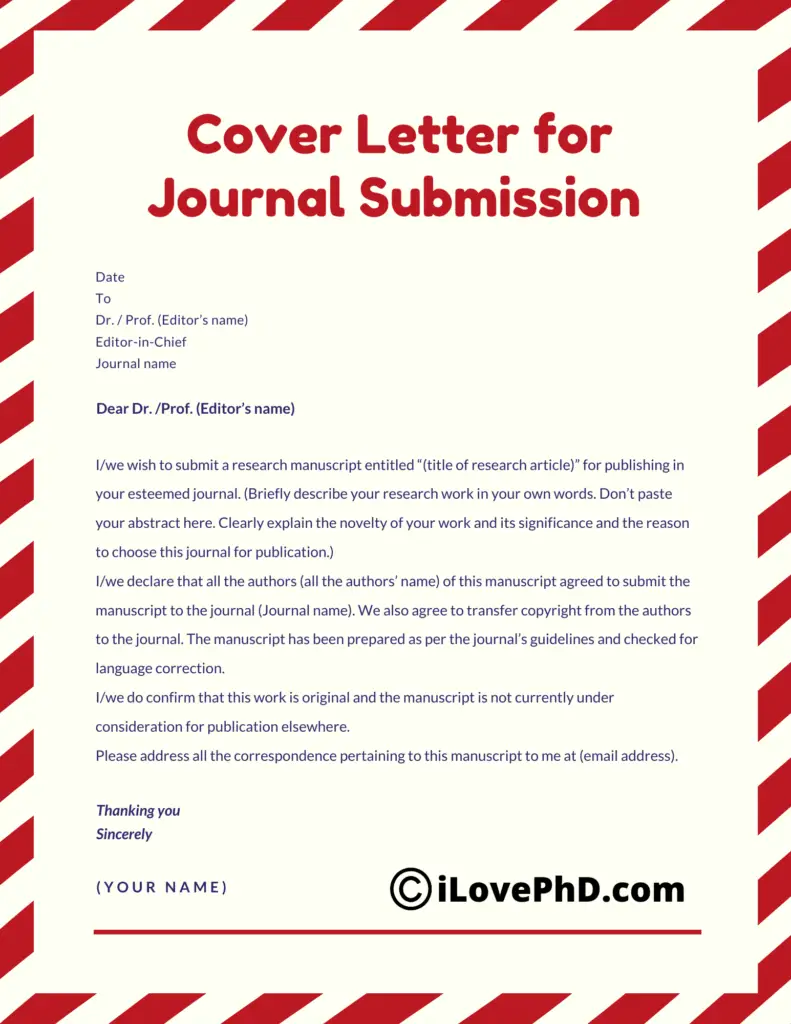
I Hope, this article helps you to know how to write an effective cover letter with an example to a journal for research article submission.
You May Also Love to Read:
How to Publish in High Impact Journals? | iLovePhD
How to Write a Research Paper? Research Paper Format | iLovePhD
How to Write a Thesis ? PhD Thesis Format | iLovePhD
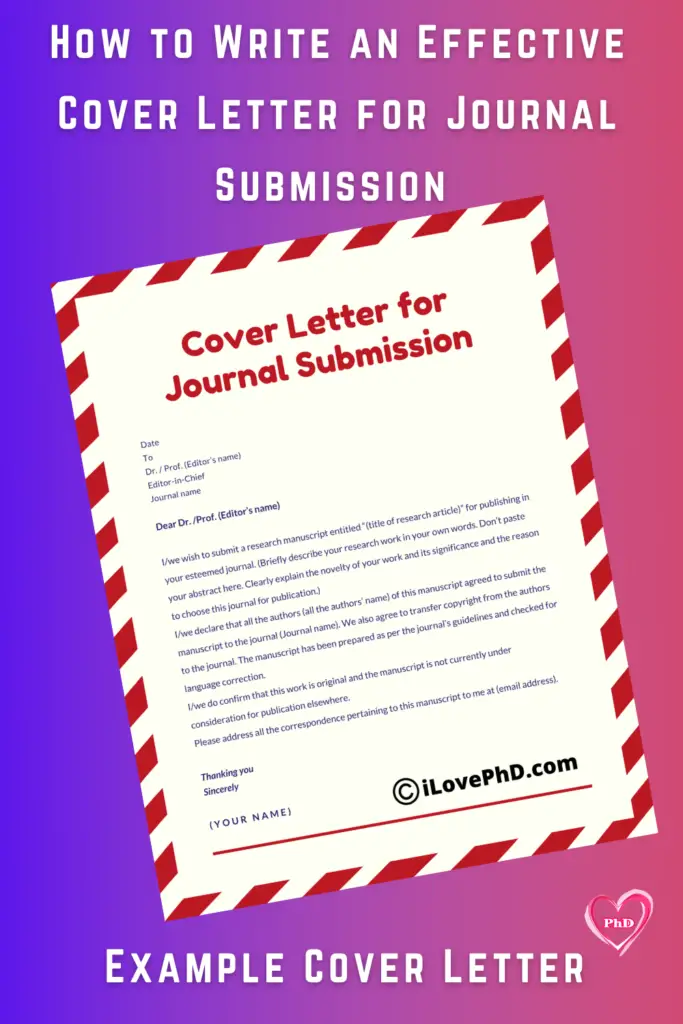
- Cover Letter
- cover letter for journal submission
- cover letter for manuscript submission
- cover letter research paper
- cover letter two corresponding author
- journal cover letter
List of Open Access SCI Journals in Computer Science
24 best online plagiarism checker free – 2024, scopus indexed journals list 2024, leave a reply cancel reply, most popular, 5 free data analysis and graph plotting software for thesis, the hrd scheme india 2024-25, 6 best online chemical drawing software 2024, imu-simons research fellowship program (2024-2027), india science and research fellowship (isrf) 2024-25, how to write a research paper in a month, example of abstract for research paper – tips and dos and donts, best for you, what is phd, popular posts, how to check scopus indexed journals 2024, popular category.
- POSTDOC 317
- Interesting 258
- Journals 234
- Fellowship 130
- Research Methodology 102
- All Scopus Indexed Journals 92
Mail Subscription

iLovePhD is a research education website to know updated research-related information. It helps researchers to find top journals for publishing research articles and get an easy manual for research tools. The main aim of this website is to help Ph.D. scholars who are working in various domains to get more valuable ideas to carry out their research. Learn the current groundbreaking research activities around the world, love the process of getting a Ph.D.
Contact us: [email protected]
Google News
Copyright © 2024 iLovePhD. All rights reserved
- Artificial intelligence

- Discoveries
- Right Journal
- Journal Metrics
- Journal Fit
- Abbreviation
- In-Text Citations
- Bibliographies
- Writing an Article
- Peer Review Types
- Acknowledgements
- Withdrawing a Paper
- Form Letter
- ISO, ANSI, CFR
- Google Scholar
- Journal Manuscript Editing
- Research Manuscript Editing
Book Editing
- Manuscript Editing Services
Medical Editing
- Bioscience Editing
- Physical Science Editing
- PhD Thesis Editing Services
- PhD Editing
- Master’s Proofreading
- Bachelor’s Editing
- Dissertation Proofreading Services
- Best Dissertation Proofreaders
- Masters Dissertation Proofreading
- PhD Proofreaders
- Proofreading PhD Thesis Price
- Journal Article Editing
- Book Editing Service
- Editing and Proofreading Services
- Research Paper Editing
- Medical Manuscript Editing
- Academic Editing
- Social Sciences Editing
- Academic Proofreading
- PhD Theses Editing
- Dissertation Proofreading
- Proofreading Rates UK
- Medical Proofreading
- PhD Proofreading Services UK
- Academic Proofreading Services UK
Medical Editing Services
- Life Science Editing
- Biomedical Editing
- Environmental Science Editing
- Pharmaceutical Science Editing
- Economics Editing
- Psychology Editing
- Sociology Editing
- Archaeology Editing
- History Paper Editing
- Anthropology Editing
- Law Paper Editing
- Engineering Paper Editing
- Technical Paper Editing
- Philosophy Editing
- PhD Dissertation Proofreading
- Lektorat Englisch
- Akademisches Lektorat
- Lektorat Englisch Preise
- Wissenschaftliches Lektorat
- Lektorat Doktorarbeit
PhD Thesis Editing
- Thesis Proofreading Services
- PhD Thesis Proofreading
- Proofreading Thesis Cost
- Proofreading Thesis
- Thesis Editing Services
- Professional Thesis Editing
- Thesis Editing Cost
- Proofreading Dissertation
- Dissertation Proofreading Cost
- Dissertation Proofreader
- Correção de Artigos Científicos
- Correção de Trabalhos Academicos
- Serviços de Correção de Inglês
- Correção de Dissertação
- Correção de Textos Precos
- 定額 ネイティブチェック
- Copy Editing
- FREE Courses
- Revision en Ingles
- Revision de Textos en Ingles
- Revision de Tesis
- Revision Medica en Ingles
- Revision de Tesis Precio
- Revisão de Artigos Científicos
- Revisão de Trabalhos Academicos
- Serviços de Revisão de Inglês
- Revisão de Dissertação
- Revisão de Textos Precos
- Corrección de Textos en Ingles
- Corrección de Tesis
- Corrección de Tesis Precio
- Corrección Medica en Ingles
- Corrector ingles
Select Page
Three Cover Letter Templates to Journal Editors
Posted by Rene Tetzner | Aug 26, 2021 | How To Get Published | 0 |

Three Cover Letter Templates to Journal Editors Each cover letter is unique, and those addressed to journal editors by scientists and academics when they submit their writing for publication are no exception. As an opportunity to present original research in the best possible light, a cover letter is indispensible for persuading a busy editor that a manuscript is worthy of peer review. A letter can only achieve this goal, however, if it is well written, contains everything the particular journal’s author instructions request for cover letters and offers specific and detailed information about why the research reported and the paper itself are perfect for the journal and of special interest to its readers. The originality that should characterise an excellent cover letter therefore prevents the wholesale use of a universal template without significant alterations, but the three sample letters that appear below may prove helpful for scholars who are planning, formatting and drafting a professional cover letter to a journal editor.

The content of the three sample letters is entirely fictional, with the dates, names, titles and situations invented. The specifics pertinent to your own research, your manuscript and the journal you are targeting will give you the raw material to emulate these templates. The format of a traditional business letter has been observed, so contact information for the authors and editors has been provided as complete mailing addresses. This formality may not be strictly necessary when communicating with a journal editor via email, where such details are often truncated, but the complete forms are always acceptable, and proper names and titles are a necessity. If possible, the official letterhead of the university, department or other research body with which you are affiliated should be used along with your name, phone number and professional email address.
Descriptions of the research and manuscript in each of the three examples have been kept simple so that the meaning will be clear to readers of all specialisations, but there are certainly successful cover letters that delve into a good deal more detail. Letter 2 below, for instance, might productively say more about the specific lights used and tomato plants grown and provide numbers and percentages as well. Do keep in mind, however, that the clarity and accessibility offered by a short and simple approach is also valuable, particularly when writing to an editor who may not share your precise specialisation.

Letter 1 adopts the perspective of a doctoral candidate who has rewritten the literature review chapter of his thesis as a bibliographical study and is seeking publication for the first time. Letter 2 introduces a research paper written by several authors and demonstrates how to act as the corresponding author when submitting a multi-author manuscript. Letter 3 posits that the author met the journal editor at a recent conference where an earlier version of the paper now being submitted for a theme issue of the journal was presented.
Download –> Letter 1: A Doctoral Candidate Seeking His First Publication
Joe Student Department of English University of the Western Shore San Francisco, CA, USA 98765 777-999-8888 [email protected]
Dr. Brian Editing Editor-in-Chief Journal of Analytical Middle English Bibliography New York, NY, USA 12345 [email protected]

November 8, 2017
Dear Dr. Editing,
I am writing to submit my article entitled ‘A Bibliography of Hoccleve Studies from the Fifteenth Century to 2017: Patterns of Readership and Response’ for publication in the Journal of Analytical Middle English Bibliography . This manuscript is based on a chapter of my doctoral thesis, supervised by Dr Hoccleve Specialist, and has not been published or submitted elsewhere for consideration.
I believe this manuscript is appropriate for the Journal of Analytical Middle English Bibliography because it combines a complete list and critical summary of previous studies with an in-depth analysis of not only individual contributions, but also the larger patterns of scholarship and their possible significance through the centuries. As I argue in the paper, the autobiographical nature of Hoccleve’s writing and the bouts of madness he claims to have experienced are topics upon which perspectives and approaches swing on a particularly long pendulum. Shifts in opinion regarding the literary quality of Hoccleve’s poetry are similarly striking. Current trends and the annotated Hoccleve bibliography will likely prove of special interest to many of your readers, enabling future research and encouraging scholarly self-awareness.
If you decide to consider the manuscript for publication, I suggest the following two experts as qualified reviewers:
Dr. Medieval Scholarship Professor of English, Southern University [email protected]
Dr. Manuscript Expert Director of Medieval Studies, Northern University [email protected]
Many thanks for your time and consideration. I look forward to your response.
Joe Student
Joe Student Ph.D. Candidate and Teaching Assistant Department of English University of the Western Shore
Download –> Letter 2: A Corresponding Author Submitting an Article Written by Several Researchers
Jane Researcher Private Plant Research Institute 9201 Pink Greenhouse Place Coquitlam, BC, Canada, V0V 1A1 604-604-6044 [email protected]
Dr Samuel Botanist Managing Editor Growing Our Greenhouse: A Journal of Current Research 2020 Glass Hill Colorado Springs, CO, USA, 59678 [email protected]
November 22, 2017
Dear Dr Botanist,
I am delighted to submit an original research article entitled ‘LED Lights Increase Vitamin C Content in Greenhouse Cherry Tomatoes’ for publication in Growing Our Greenhouse: A Journal of Current Research . My colleagues and I at the Private Plant Research Institute in Coquitlam conducted the research and coauthored the manuscript; a full list of the names and affiliations of all ten coauthors is attached. We have all approved the manuscript for submission to Growing Our Greenhouse , and I have been chosen as the corresponding author.
The article is particularly appropriate for the journal’s section dedicated to the cultivation of fruits and vegetables. It is, in fact, a continuation of the research presented in our article ‘Can LED Lights Really Replace the Sun for Tomatoes?’ which was published in that section of Growing Our Greenhouse two years ago. Then we were analysing the results of our first two seasons of growing tomatoes under LED lights. One of the unexpected discoveries we made as we determined which plants and lights produced the best results was that vitamin C content appeared to increase when the ripening fruit was exposed to LED light.
The research reported in the manuscript I am submitting today was designed to investigate further the apparent increases in vitamin C. Its methodology is similar to that of our earlier study, but we used only those cherry tomato plants that we had already shown could thrive under LED lights. We also established a larger number of experimental groups to explore the effects of variables such as light colour, light intensity, hours of exposure, ambient temperature and presence or absence of sunlight. Our findings were convincing to say the least, with vitamin C content doubling and sometimes trebling in fruit exposed to additional LED light. Even fruit given only LED lighting and deprived of all natural sunlight far exceeded the vitamin C content of those tomatoes exposed to natural sunlight alone.
We trust that your readers will find our hands-on empirical method as effective as they have in the past and benefit from our practices and discoveries as they grow and experiment in their own greenhouses.
Thank you for your continuing interest and consideration.
Yours sincerely,
Jane Researcher
Jane Researcher Research Director, Private Plant Research Institute
Download –> Letter 3: A Conference Participant Submitting a Paper to the Journal Editor She Met
Sheila Presenter Chair, School of Business Management Yorkshire University 2121 University Road York, North Yorkshire, UK, YO33 7EE 01904 323232 [email protected]
Dr Margaret Publisher Editor-in-Chief Journal of Innovative Business Studies 178B West Central Avenue London, UK, EC9M 6BB [email protected]
25 November 2017
Dear Dr Publisher,
It was a pleasure meeting you and discussing our similar interests at the Business Management conference in London a couple of weeks ago. As promised, I have revised my presentation and am submitting it for your consideration for the upcoming issue of the Journal of Innovative Business Studies dedicated to management innovations. The new title of the manuscript is ‘Empathy as a Management Strategy Yields Significant Increases in Efficiency and Productivity.’
You might recall that we discussed the challenges of reshaping my presentation, which was designed to generate in conference attendees the emotional responses it discusses, to conform to the structural requirements of the Journal of Innovative Business Studies . The journal’s author instructions were actually very helpful, and I believe the overall argument of the paper is now clearer as a result of the rearrangement. I also took a look at the recent Journal of Innovative Business Studies articles by Sally Scholar and John Researcher that you recommended. The former was particularly helpful and I have cited it more than once in my closing discussion. That discussion has benefited significantly from our long talk at the conference and I hope you do not object to my acknowledgement of your insight.
As you know, the research presented in the manuscript is original and has not been published or submitted elsewhere. My methods comply with the journal’s ethical standards, I have no conflicts of interest to disclose and I have removed all traces of my identity in preparation for blind review. I would respectfully request that Stephen Harsh not review the manuscript, however. His knowledge in this area is extensive, but you may remember from his comments at the conference that he does not share my approach to management or view my recent research with a positive eye. I believe the following two experts would serve as more appropriate reviewers of my paper:
Frederick Newapproach CEO, Management Innovations UK Inc. [email protected] Samantha Kindheart Chair, Department of Business Management University of the Wolds [email protected]
I look forward to seeing you at the upcoming conference in Leeds. In the meantime, let me take this opportunity to thank you for your interest and consideration.
Best regards,
Sheila Presenter
Sheila Presenter Chair, School of Business Management Yorkshire University
You might be interested in Services offered by Proof-Reading-Service.com
Journal editing.
Journal article editing services
PhD thesis editing services
Scientific Editing
Manuscript editing.
Manuscript editing services
Expert Editing
Expert editing for all papers
Research Editing
Research paper editing services
Professional book editing services
Related Posts

Choosing the Right Journal
September 10, 2021

Example of a Quantitative Research Paper
September 4, 2021

What Is a Good H-Index Required for an Academic Position?
September 3, 2021

Acknowledgements Example for an Academic Research Paper
September 1, 2021
Our Recent Posts

Our review ratings
- Examples of Research Paper Topics in Different Study Areas Score: 98%
- Dealing with Language Problems – Journal Editor’s Feedback Score: 95%
- Making Good Use of a Professional Proofreader Score: 92%
- How To Format Your Journal Paper Using Published Articles Score: 95%
- Journal Rejection as Inspiration for a New Perspective Score: 95%
Explore our Categories
- Abbreviation in Academic Writing (4)
- Career Advice for Academics (5)
- Dealing with Paper Rejection (11)
- Grammar in Academic Writing (5)
- Help with Peer Review (7)
- How To Get Published (146)
- Paper Writing Advice (17)
- Referencing & Bibliographies (16)
Cover letters
A good cover letter will help "sell" your manuscript to the journal editor. it is not enough to send a manuscript to a journal editor like this:.
Dear Editor-in-Chief,
I am sending you our manuscript entitled "Large Scale Analysis of Cell Cycle Regulators in bladder cancer" by Researcher et al. We would like to have the manuscript considered for publication in Pathobiology.
Please let me know of your decision at your earliest convenience.
With my best regards,
Sincerely yours,
A Researcher, PhD
Instead, check to see whether the journal's Instructions for Authors have any cover letter requirements (e.g., disclosures, statements, potential reviewers).
Then, write a letter that explains why the Editor would want to publish your manuscript:
Common phrases:
- Please find enclosed our manuscript, "[manuscript title]" by [first author's name] et al., which we would like to submit for publication as a [publication type] in [name of the journal].
- To our knowledge, this is the first report showing...
- We believe our findings would appeal to the readership of [journal name].
- Please address all correspondence to:
- We look forward to hearing from you at your earliest convenience.
All cover letters should contain these sentences:
- We confirm that this manuscript has not been published elsewhere and is not under consideration by another journal.
- All authors have approved the manuscript and agree with its submission to [insert the name of the target journal].
Submission checklist Before submitting your manuscript, thoroughly check its quality one more time. Evaluate it critically-could anything be done better?
Be sure that:
- The manuscript follows the submission guidelines
- All files are in the correct file format and of the appropriate resolution or size
- The spelling and grammar are correct
- You have contact information for all authors
- You have completed online registration for the submission process for your target journal
- You have written a persuasive cover letter
13 Professional Researcher Cover Letter Examples for 2024
Your researcher cover letter must showcase your academic excellence and research skills. Highlight your publications or any relevant projects that demonstrate expertise in your field. Connect your past experiences with the potential role, indicating how they make you an ideal candidate. It's crucial to convey your passion for the subject and how you can contribute valuable insights to the team.
All cover letter examples in this guide

UX Researcher
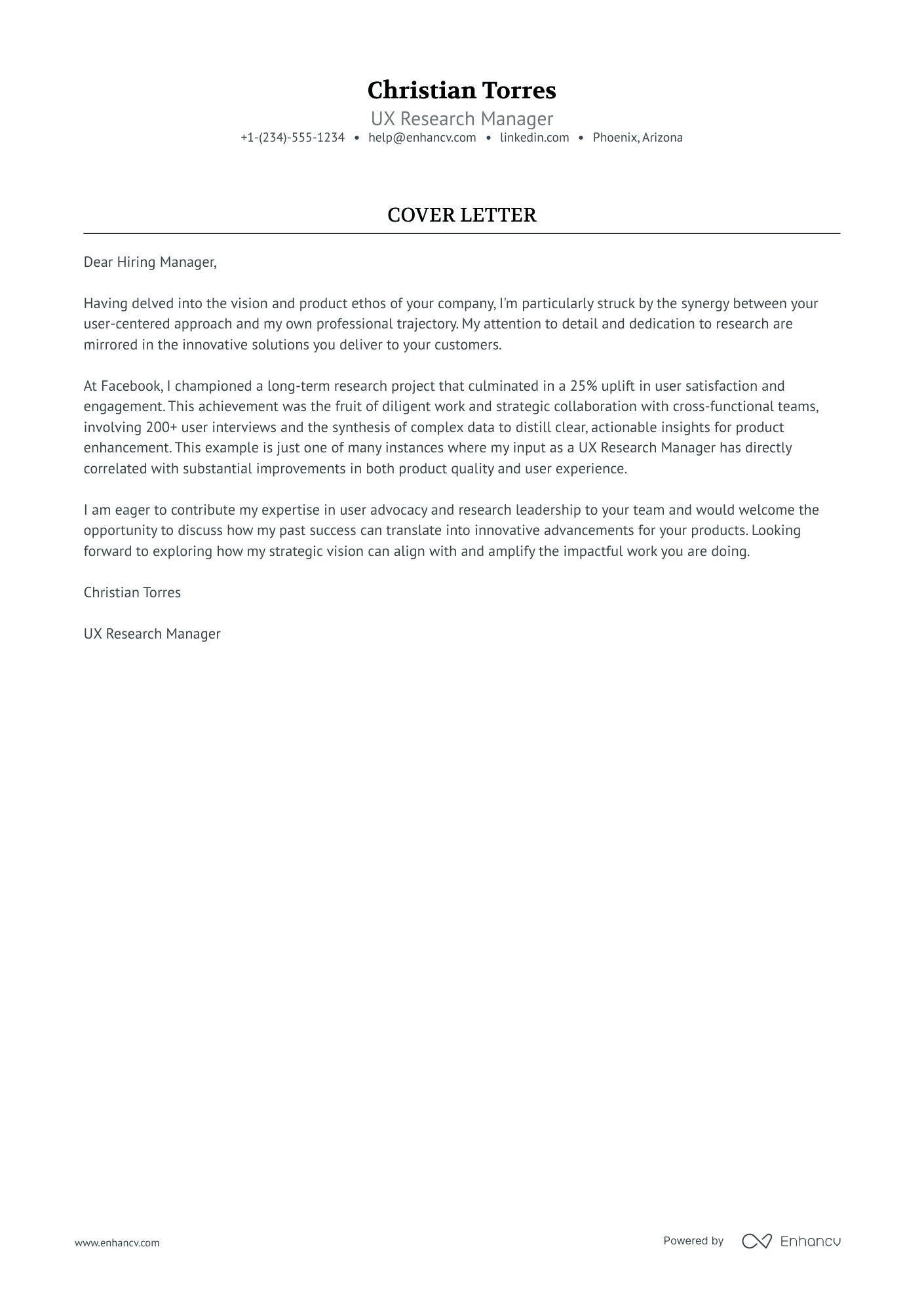
Product Researcher
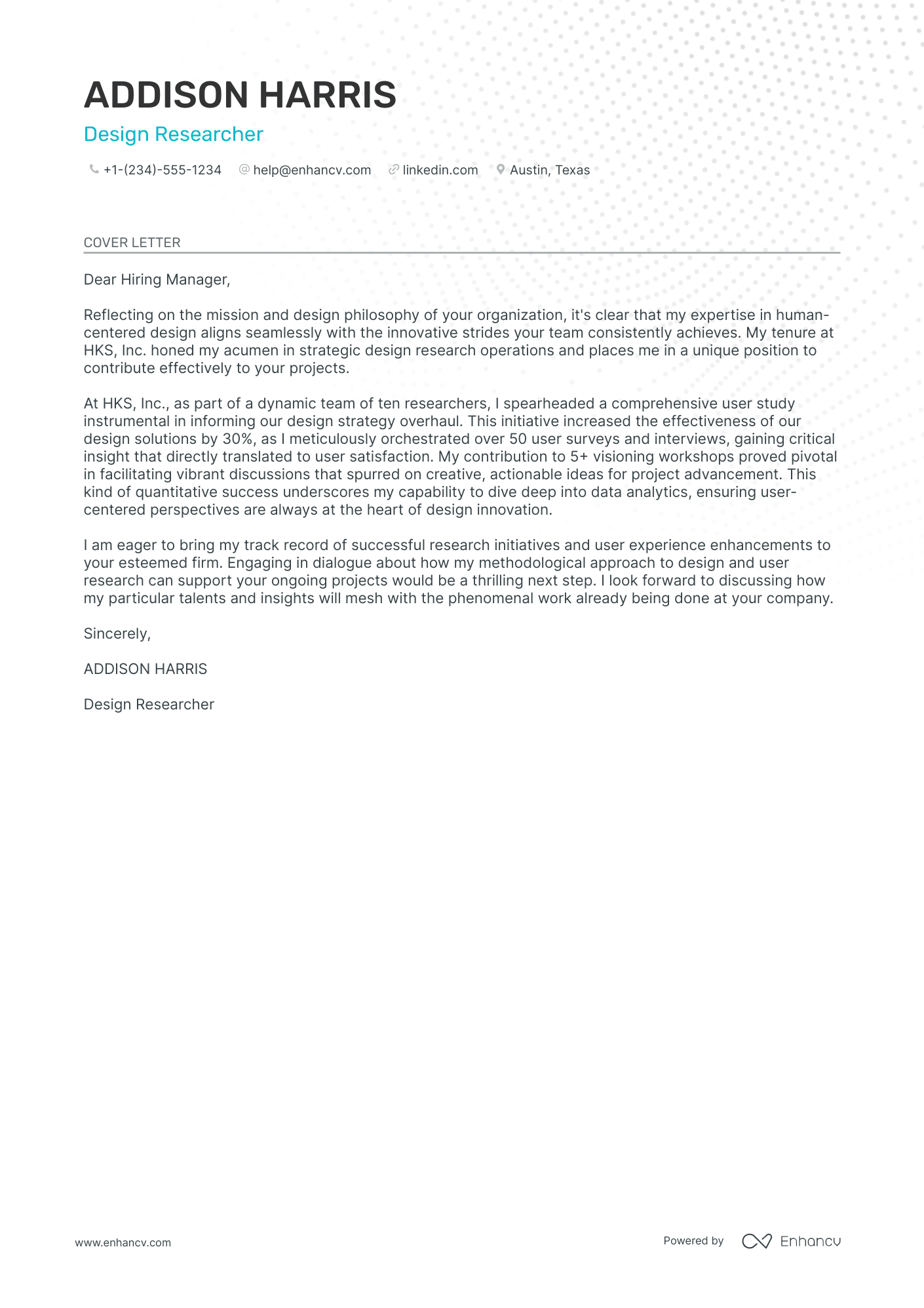
Design Researcher
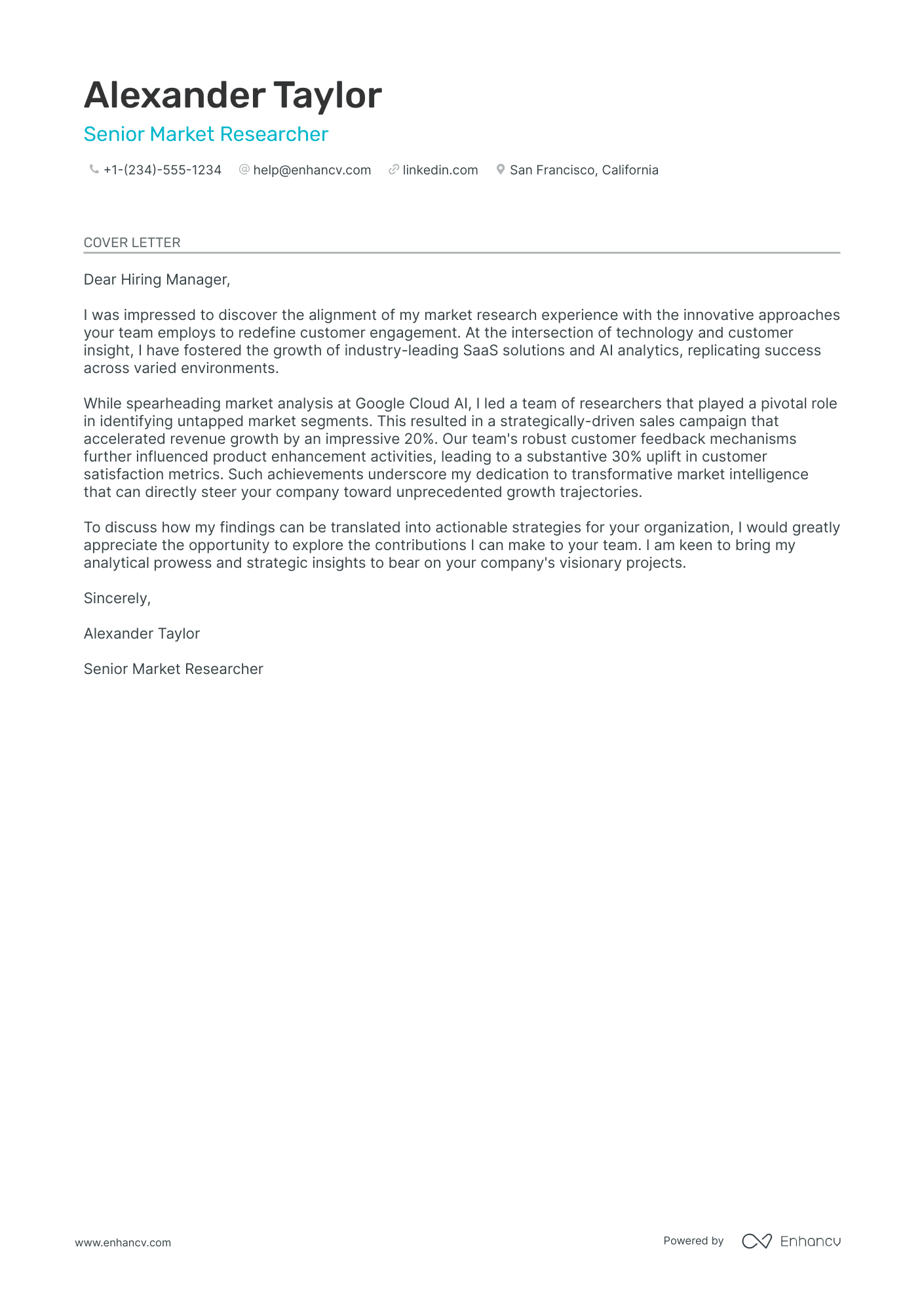
Market Researcher
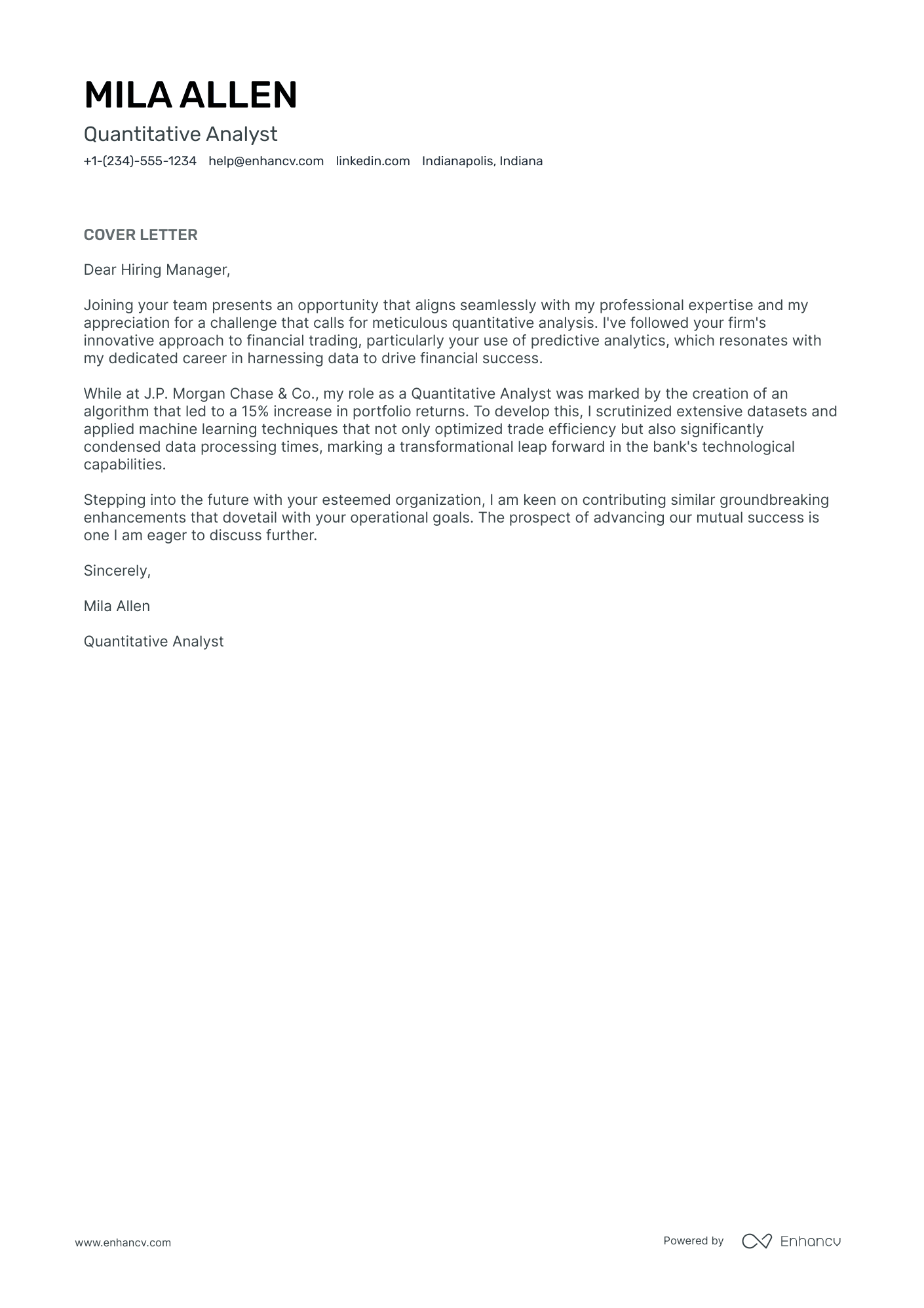
Quantitative Researcher

Lab Researcher
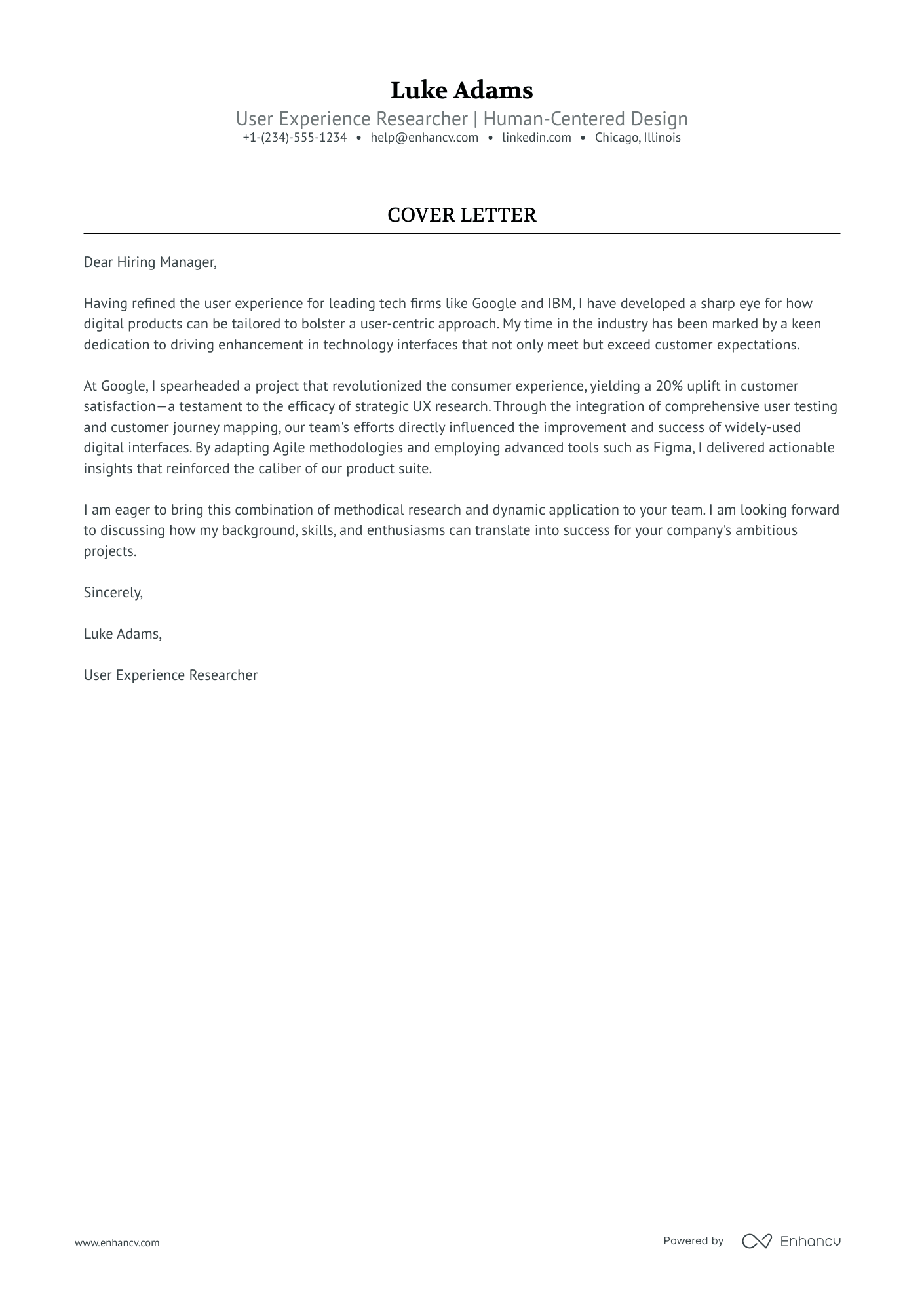
User Researcher

Undergraduate Researcher
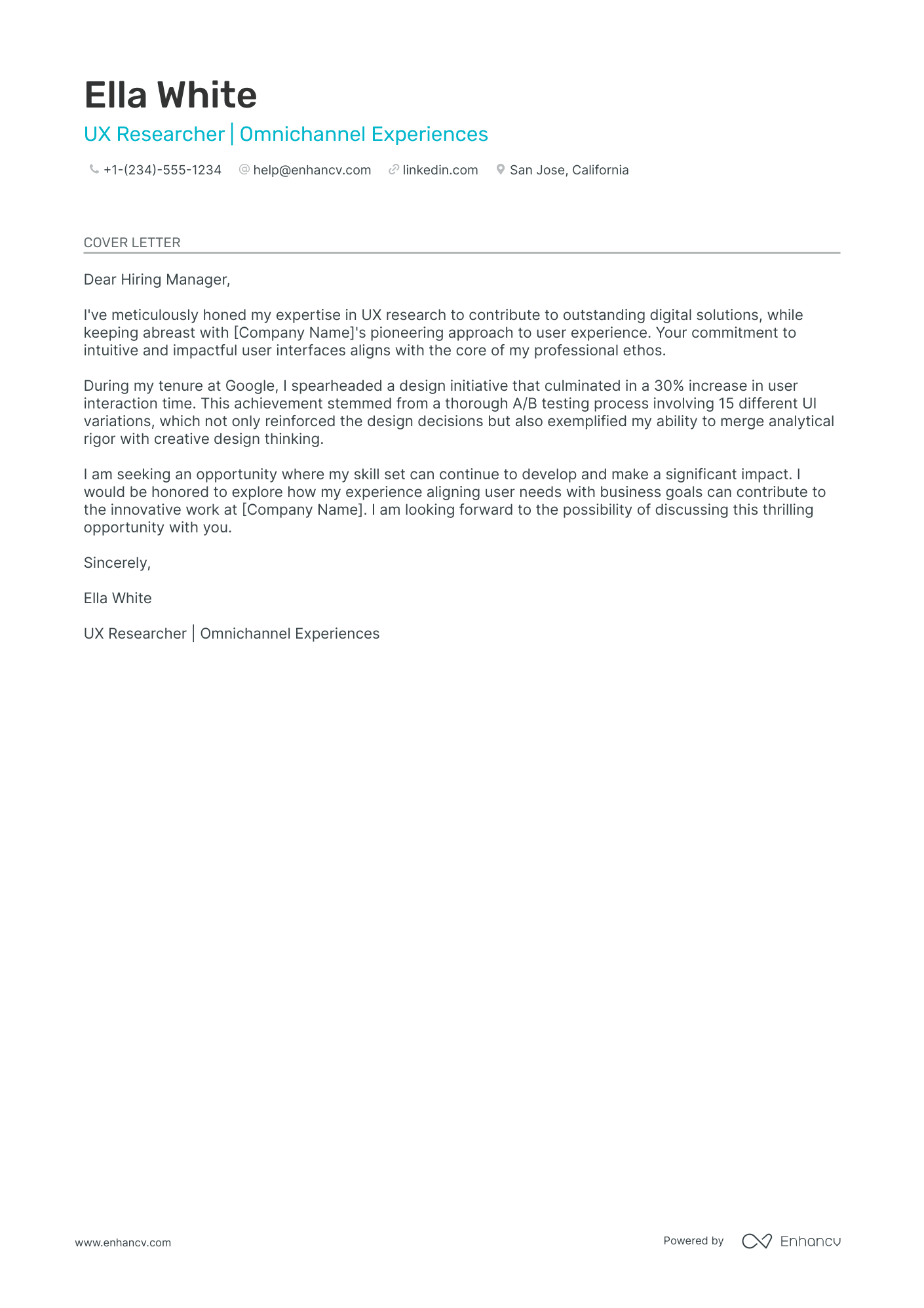
Psychology Researcher

Student Researcher

Machine Learning Researcher

Qualitative Researcher
Cover letter guide.
Researcher Cover Letter Sample
Cover Letter Format
Cover Letter Salutation
Cover Letter Introduction
Cover Letter Body
Cover Letter Closing
No Experience Researcher Cover Letter
Key Takeaways

Embarking on the job hunt, you’ve likely discovered the need to complement your resume with a researcher cover letter—a daunting task for many. Surpassing the routine checklist of your resume, your cover letter should weave a compelling narrative around your proudest professional milestone. It must strike the delicate balance between formal tone and original expression, avoiding overused phrases that dull your accomplishments. Keep it concise; this powerful one-pager is your chance to captivate and convince.
- Personalize the greeting to address the recruiter and your introduction that fits the role;
- Follow good examples for individual roles and industries from job-winning cover letters;
- Decide on your most noteworthy achievement to stand out;
- Format, download, and submit your researcher cover letter, following the best HR practices.
Use the power of Enhancv's AI: drag and drop your researcher resume, which will swiftly be converted into your job-winning cover letter.
If the researcher isn't exactly the one you're looking for we have a plethora of cover letter examples for jobs like this one:
- Researcher resume guide and example
- Clinical Research Assistant cover letter example
- Research Associate cover letter example
- Lab Assistant cover letter example
- Undergraduate Research Assistant cover letter example
- Lab Technician cover letter example
- Entry Level Chemist cover letter example
- Biology cover letter example
- Research Assistant cover letter example
- Scientist cover letter example
- Research Manager cover letter example
Researcher cover letter example
Samuel Moore
Columbus, Ohio
+1-(234)-555-1234
- Demonstration of past experience relevant to the role, such as leading a comprehensive evaluation of digital resources, indicates the candidate's ability to perform similar tasks at Ithaka S+R.
- Quantifiable achievements in previous roles, like improving project efficiency by 25%, show the candidate's potential to add measurable value to Ithaka S+R's projects.
- Alignment with the organization's mission, seen in the candidate's expression of shared goals regarding academic growth and equity, suggests a good fit with the team and its objectives.
- Mention of specific skills, such as advanced qualitative methodologies and strategic project management, matches the skill set required for a successful researcher at Ithaka S+R.
The must-have sections and format of your researcher cover letter
When writing your researcher cover letter, keep in mind that it'll only be read by the recruiters and not the Applicant Tracker System (or software used to assess your profile). That's why you should structure your content with a/an:
- Header (apart from your contact information, include your name, the role you're applying for, and the date);
- Personalized salutation;
- Opening paragraph to win the recruiters over;
- Middle paragraph with key details;
- Closing that starts from clichés;
- Sign off (that's not mandatory).
Industry standards dictate your paragraphs to be single-spaced and to wrap your content in a one-inch margin. Designing your researcher cover letter, refer to one of our templates , which automatically takes care of the spacing and margins.
Choose the same font for your researcher cover letter as you did for your resume : the likes of Lato and Bitter would help you to stand out in a sea of cover letters in Arial or Times New Roman.
Export your whole researcher cover letter from our builder in PDF to keep the same formatting and image quality.
The top sections on a researcher cover letter
- Header: Include your contact information, the date, and the employer's contact information, ensuring you can be easily reached for follow-up and portraying a professional format specific to researchers who value detail orientation.
- Greeting: Address the hiring manager or committee directly, if known, to show you've done your research, which is a critical skill for any research position.
- Introduction: Clearly state the research position you're applying for, mention how you found the job listing, and include a hook that summarizes your enthusiasm and fit for the role, demonstrating your genuine interest and initiative in the field.
- Body: Detail your previous research experience, publications, and how your skills align with the job requirements, showing that you can contribute significantly to the ongoing projects or academic pursuits of the organization.
- Closing: Express your eagerness to discuss further how you can contribute to the team, thank the reader for considering your application, and indicate that you have attached your CV or any relevant publications, establishing a call-to-action and preparation for the next steps.
Key qualities recruiters search for in a candidate’s cover letter
Proven track record in conducting independent research and publishing in peer-reviewed journals: It demonstrates the ability to contribute to the scientific community with original findings.
Expertise in specialized techniques or methodologies unique to the field: This shows the candidate possesses the technical skills necessary to perform and contribute to cutting-edge research.
Successful grant writing experience: Securing funding is critical for research; this skill indicates the candidate can attract the necessary resources to support their work.
Prior involvement in collaborative projects with multidisciplinary teams: Research increasingly requires collaboration across various disciplines, so the ability to work with diverse teams is highly valued.
Evidence of critical thinking and problem-solving abilities: Researchers must be able to tackle complex problems, analyze data, and draw meaningful conclusions that propel the field forward.
Strong communication skills, both written and oral: The ability to effectively communicate research findings to a wide range of audiences, including non-specialists, is essential for disseminating knowledge and advancing one's career in academia or industry.
How to start your researcher cover letter: with a greeting, of course
Have you ever considered just how powerful a personalized salutation can be?
We sure have news for you! Your researcher cover letter should start with the right salutation to recruiters, nurturing a sense of respect and individuality.
Greet recruiters by using their first name (e.g. "Dear Tom" or "Dear Patricia") if you've previously established contact with them.
Otherwise, opt out for the less familiar, "Dear Ms. Peaches" or "Dear Ms Kelsey", if you've found the recruiter's name on LinkedIn or a corporate website.
"To whom it may concern" is never a good option, as it creates a sense that you've been sending out your researcher cover letter to anyone. Instead, use "Dear HR team" or "Dear (company name) recruiter" for a feeling of exclusivity.
List of salutations you can use
- Dear Dr. [Last Name],
- Dear Professor [Last Name],
- Dear Hiring Committee,
- Dear Search Committee,
- Dear [Full Name],
- Dear Mr./Ms. [Last Name],
Using your researcher cover letter intro to show your dedication
We know just how difficult it is to start writing your researcher cover letter introduction .
There are so many great qualities you have as a professional, which one should you choose?
How about writing up to two sentences about your passion and commitment to the work you do or are set to do?
Try to describe exactly what you enjoy about the potential role.
A positive attitude from the get-go will help you stand out as a motivated researcher professional.
Choosing your best achievement for the middle or body of your researcher cover letter
Now that you have the recruiters' attention, it's time to write the chunkiest bit of your researcher cover letter .
The body consists of three to six paragraphs that focus on one of your achievements.
Use your past success to tell a story of how you obtained your most job-crucial skills and know-how (make sure to back these up with tangible metrics).
Another excellent idea for your researcher cover letter's middle paragraphs is to shine a light on your unique professional value.
Write consistently and make sure to present information that is relevant to the role.
Finishing off your researcher cover letter with what matters most
So far, you've done a fantastic job in tailoring your researcher cover letter for the role and recruiter.
Your final opportunity to make a good impression is your closing paragraph.
And, no, a "Sincerely yours" just won't do, as it sounds too vague and impersonal.
End your researcher cover letter with the future in mind.
So, if you get this opportunity, what do you plan to achieve? Be as specific, as possible, of what value you'd bring to the organization.
You could also thank recruiters for their interest in your profile and prompt for follow-up actions (and organizing your first interview).
Researcher cover letter advice for candidates with no experience
If you're worried about writing your Researcher cover letter and have no professional experience , we sure have some advice for you.
Turn recruiters' attention to your transferable or relevant skills gained thanks to your life and work experience.
Instead of writing about past jobs, focus on one achievement (whether from your volunteering experience, education, etc.) and the skills it has helped you build.
Alternatively, you could focus your Researcher cover letter on your career objectives and goals. Always remember to make those relevant to the job you're applying for by detailing how you see yourself growing as part of the company.
Recruiters would be way more impressed with candidates who fit the job profile and can bring about plenty of skills and vision to the table.
Key takeaways
Summarizing the most important aspects in writing your researcher cover letter, remember to:
- Create a personalized researcher cover letter for each role you apply for, that includes the recruiter's name in the salutation;
- Format your researcher cover letter with single-spacing, one-inch margins, and a modern, yet ATS-friendly font;
- Always start off your researcher cover letter with two sentences that reflect what is most important about your application;
- Your researcher cover letter body should feature your biggest accomplishments and the job-relevant skills it has taught you;
- Instead of opting for the "Sincerely yours" ending, close your researcher cover letter with a nod to the future with what you aim to achieve in this potential role.
Researcher cover letter examples
Explore additional researcher cover letter samples and guides and see what works for your level of experience or role.
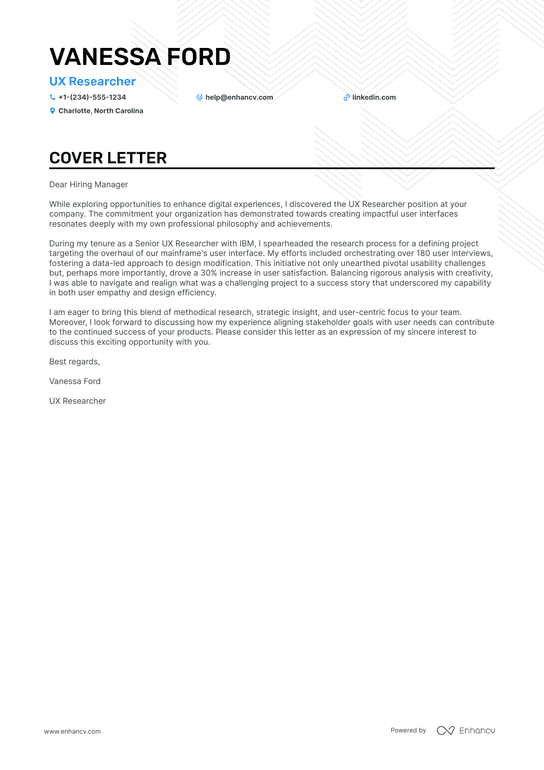
Cover letter examples by industry

AI cover letter writer, powered by ChatGPT
Enhancv harnesses the capabilities of ChatGPT to provide a streamlined interface designed specifically focused on composing a compelling cover letter without the hassle of thinking about formatting and wording.
- Content tailored to the job posting you're applying for
- ChatGPT model specifically trained by Enhancv
- Lightning-fast responses

How to List Publications on a Resume: A Guide for Researchers
+20 useful chatgpt prompts to optimize your linkedin profile for the dream job, dates on resume: how to format, templates & tips, resume sections: everything you need to know, how to get a job in silicon valley: industry trends, secrets, and expert advice in 2024, how to film a video resume.
- Create Resume
- Terms of Service
- Privacy Policy
- Cookie Preferences
- Resume Examples
- Resume Templates
- AI Resume Builder
- Resume Summary Generator
- Resume Formats
- Resume Checker
- Resume Skills
- How to Write a Resume
- Modern Resume Templates
- Simple Resume Templates
- Cover Letter Builder
- Cover Letter Examples
- Cover Letter Templates
- Cover Letter Formats
- How to Write a Cover Letter
- Resume Guides
- Cover Letter Guides
- Job Interview Guides
- Job Interview Questions
- Career Resources
- Meet our customers
- Career resources
- English (UK)
- French (FR)
- German (DE)
- Spanish (ES)
- Swedish (SE)
© 2024 . All rights reserved.
Made with love by people who care.
Researcher cover letter examples
Your head is already bursting with knowledge, but you love nothing more than doing your research and gathering new information.
Well, it’s time to put those research skills to use to find out more about the company and what the employer expects from your application.
In our guide below, we’ll show you what to include in your cover letter and how to use your research to your advantage. Check out our top tips and researcher cover letter examples below.
CV templates
Researcher cover letter example 1
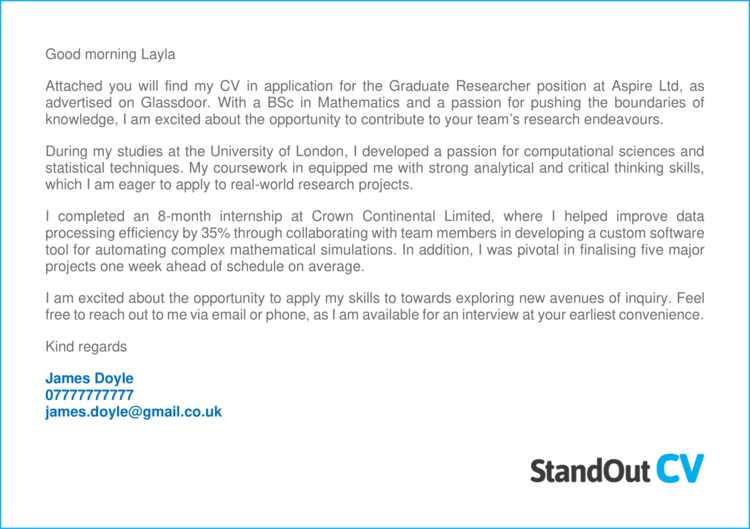
Researcher cover letter example 2
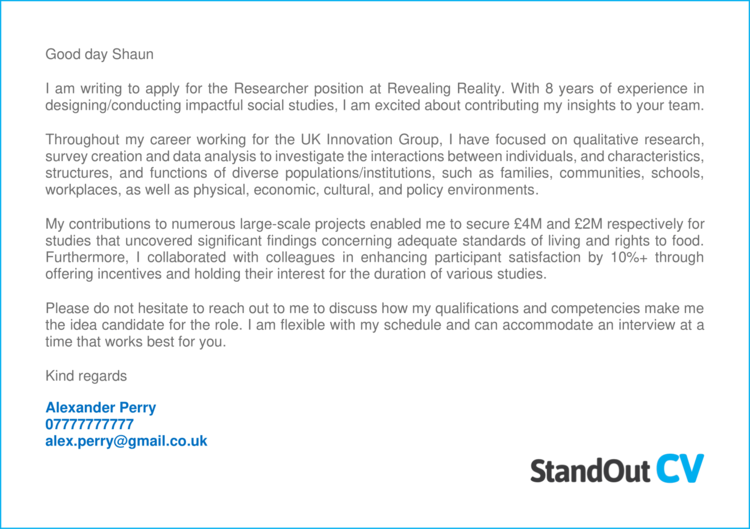
Researcher cover letter example 3
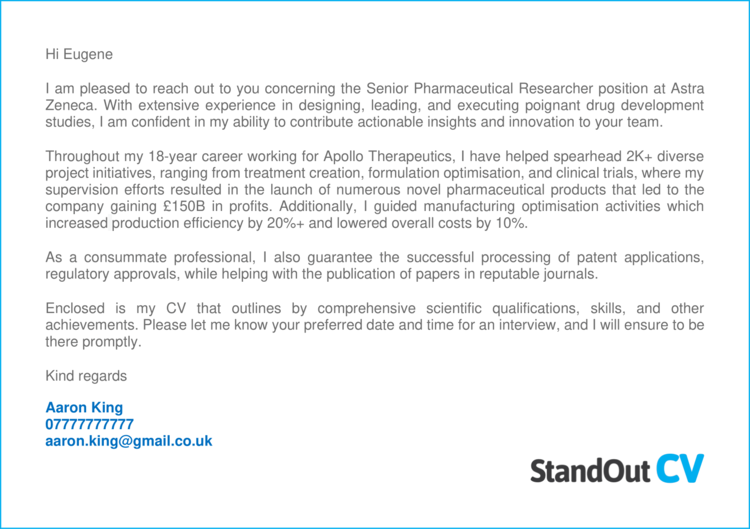
The example cover letters here should give you a good general idea on how your Researcher cover letter should be formatted and written.
The rest of this guide gives more specific guidance on how to create your own cover letter in this format, and even includes some templates you can copy and paste.
How to write a Researcher cover letter
Here’s how you can write your own eye-catching cover letter, broken down into simple steps.

Write your cover letter in the body of an email/message
When you send a cover letter with a job application, you should always write your message into the body of your email – or the body of the messaging system if you are sending via a job website.
Why do this?
Simply because you want to get your message seen as soon as the recruiter opens your application.
If you attach the cover letter as a separate item, this means the recipient will have to open it before they can read it – slowing down the process and potentially causing frustration along the way.
So, write your cover note in the body of your email/message to ensure you make an instant connection with the reader.

Start with a friendly greeting

Start you cover letter with a greeting that is professional but friendly.
This will build rapport with the recruiter whilst showing your professionalism.
- Hi, hope you’re well
- Hi [insert recruiter name]
- Hi [insert department/team name]
Avoid overly formal greetings like “Dear sir/madam ” unless applying to very traditional companies.
How to find the contact’s name?
Addressing the recruitment contact by name is an excellent way to start building a strong relationship. If it is not listed in the job advert, try these methods to find it.
- Check out the company website and look at their About page. If you see a hiring manager, HR person or internal recruiter, use their name. You could also try to figure out who would be your manager in the role and use their name.
- Head to LinkedIn , search for the company and scan through the list of employees. Most professionals are on LinkedIn these days, so this is a good bet.
Identify the role you are applying for
Once you’ve opened up the cover letter with a warm greeting to start building a relationship, it is time to identify which role you want to apply for.
Recruiters are often managing multiple vacancies, so you need to ensure you apply to the correct one.
Be very specific and use a reference number if you can find one.
- I am interested in applying for the position of Researcher with your company.
- I would like to apply for the role of Sales assistant (Ref: 406f57393)
- I would like to express my interest in the customer service vacancy within your retail department
- I saw your advert for a junior project manager on Reed and would like to apply for the role.
See also: CV examples – how to write a CV – CV profiles
Highlight your suitability
The bulk of your cover letter should be focused around highlighting your suitability for the job you are applying to.
Doing this will show the recruiter that you are suitable candidate and encourage them to open your CV.
The best way to do this, is by studying the job advert you are applying to, and find out what the most important skills and knowledge are.
Once you know the most important requirements, you then need to highlight your matching skills to the recruiter. In a few sentences, tell them exactly why you are a good fit for the job and what you can offer the company.

Keep it short and sharp
When sending a job application to a recruiter or hiring manager, it is important to remember that they will normally be very busy and pushed for time.
Therefore, you need to get you message across to them quickly (in a matter of seconds ideally). So, keep your cover letter short and to-the-point. A long waffling cover letter will overwhelm recruiters when they are running through hundreds of emails in there inbox, but a concise one will get their attention.
So, keep your cover letter to just a few sentences long, and save the extensive detail for your CV.
Sign off professionally
To finish off your cover note, add a professional signature to the bottom, stating your important contact details and information.
This not only provides recruiters with multiple means of contacting you, but it also adds a nice professional appearance to the cover letter, which shows that you know how to conduct yourself in the workplace.
Include the following points;
- A friendly sign off – e.g. “Warm regards”
- Your full name
- Phone number (one you can answer quickly)
- Email address
- Profession title
- Professional social network – e.g. LinkedIn
Here is an example signature;
Warm regards,
Aaron Smith Customer service professional 075557437373 [email protected] LinkedIn
Quick tip : To save yourself from having to write your signature every time you send a job application, you can save it within your email drafts, or on a separate document that you could copy in.

What to include in your Researcher cover letter
Your Researcher cover letter will be unique to your situation, but there are certain content guidelines you should stick to for best results.
To attract and entice recruiters, stick with the following key subjects in your cover letter – adapting them to fit your profession and target jobs.
- Your professional experience – Employers will be keen to know if your experience is suitable for the job you are applying to, so provide a good summary of it in your cover letter.
- Your qualifications and education – Highlight your most relevant and high-level of qualification, especially if they are essential to the job.
- The positive impact you have made – Employers love to hear about the benefits you can bring to them, so shout about anything impressive you have done, such as saving money or improving processes.
- Your reasons for leaving – Use a few words of your cover letter to explain why you are leaving your current job and ensure you avoid any negative reasons.
- Your availability – Let recruiters know when you can start a new job . Are you immediately available, or do you have a month notice period?
Researcher cover letter templates
Copy and paste these Researcher cover letter templates to get a head start on your own.
Good morning, Layla
Attached you will find my CV in application for the Graduate Researcher position at Aspire Ltd, as advertised on Glassdoor. With a BSc in Mathematics and a passion for pushing the boundaries of knowledge, I am excited about the opportunity to contribute to your team’s research endeavours.
During my studies at the University of London, I developed a passion for computational sciences and statistical techniques. My coursework in equipped me with strong analytical and critical thinking skills, which I am eager to apply to real-world research projects.
I completed an 8-month internship at Crown Continental Limited, where I helped improve data processing efficiency by 35% through collaborating with team members in developing a custom software tool for automating complex mathematical simulations. In addition, I was pivotal in finalising five major projects one week ahead of schedule on average.
I am excited about the opportunity to apply my skills to towards exploring new avenues of inquiry. Feel free to reach out to me via email or phone, as I am available for an interview at your earliest convenience.
Kind regards
James Doyle
Good day Shaun
I am writing to apply for the Researcher position at Revealing Reality. With 8 years of experience in designing/conducting impactful social studies, I am excited about contributing my insights to your team.
Throughout my career working for the UK Innovation Group, I have focused on qualitative research, survey creation and data analysis to investigate the interactions between individuals, and characteristics, structures, and functions of diverse populations/institutions, such as families, communities, schools, workplaces, as well as physical, economic, cultural, and policy environments.
My contributions to numerous large-scale projects enabled me to secure £4M and £2M respectively for studies that uncovered significant findings concerning adequate standards of living and rights to food. Furthermore, I collaborated with colleagues in enhancing participant satisfaction by 10%+ through offering incentives and holding their interest for the duration of various studies.
Please do not hesitate to reach out to me to discuss how my qualifications and competencies make me the idea candidate for the role. I am flexible with my schedule and can accommodate an interview at a time that works best for you.
Alexander Perry
I am pleased to reach out to you concerning the Senior Pharmaceutical Researcher position at Astra Zeneca. With extensive experience in designing, leading, and executing poignant drug development studies, I am confident in my ability to contribute actionable insights and innovation to your team.
Throughout my 18-year career working for Apollo Therapeutics, I have helped spearhead 2K+ diverse project initiatives, ranging from treatment creation, formulation optimisation, and clinical trials, where my supervision efforts resulted in the launch of numerous novel pharmaceutical products that led to the company gaining £150B in profits. Additionally, I guided manufacturing optimisation activities which increased production efficiency by 20%+ and lowered overall costs by 10%.
As a consummate professional, I also guarantee the successful processing of patent applications, regulatory approvals, while helping with the publication of papers in reputable journals.
Enclosed is my CV that outlines by comprehensive scientific qualifications, skills, and other achievements. Please let me know your preferred date and time for an interview, and I will ensure to be there promptly.
Writing a strong attention-grabbing cover letter is a vital step in landing a good Researcher job.
Use the tips, strategies and examples above to get more responses from you job applications and start lining job interview up.
Good luck with your job search!

Researcher Cover Letter Examples (Template & 20+ Tips)
Create a standout researcher cover letter with our online platform. browse professional templates for all levels and specialties. land your dream role today.
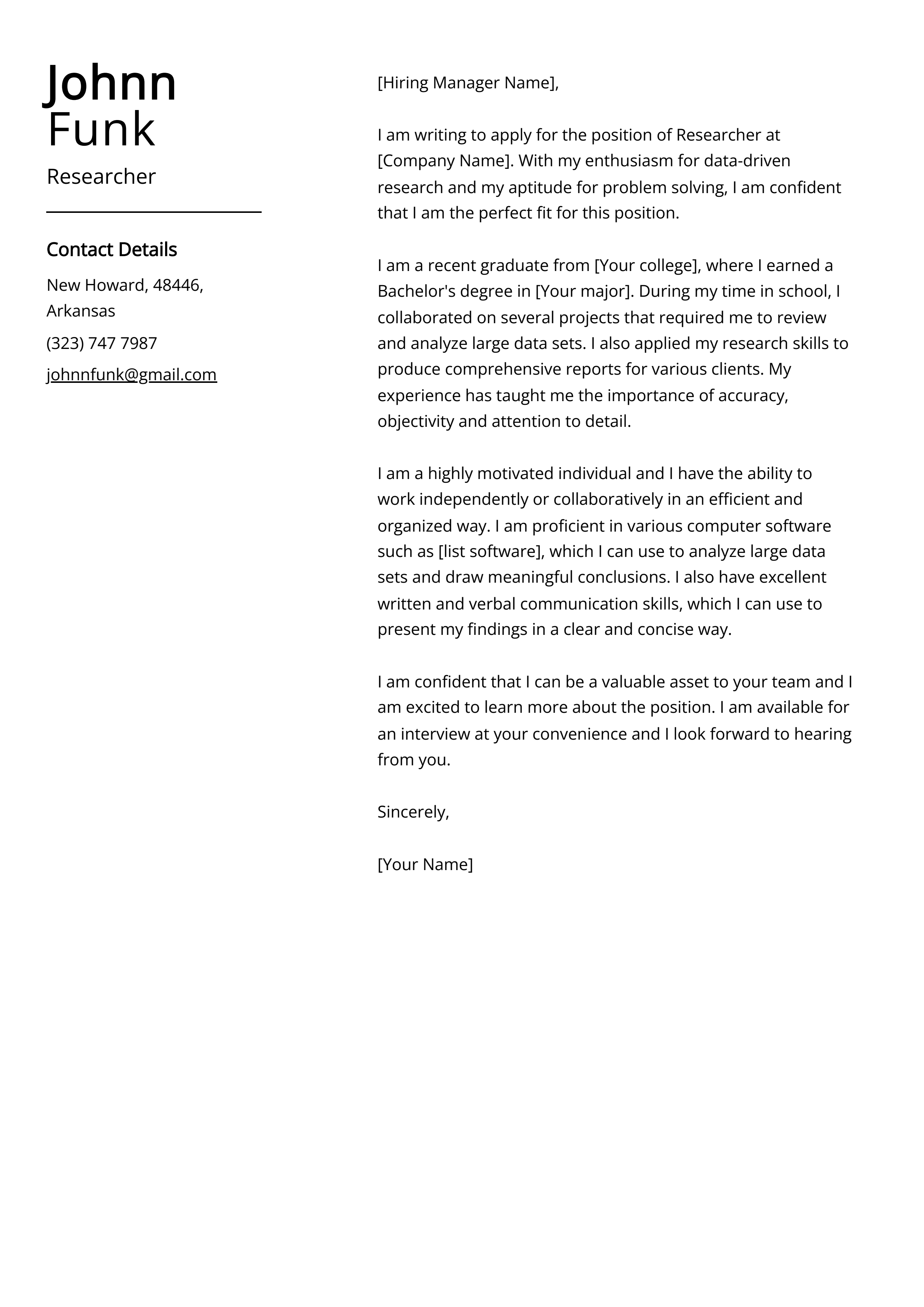
As a talented and dedicated researcher, your cover letter plays a crucial role in showcasing your skills, experience, and passion for the job. Effective communication and attention to detail are essential for success in this competitive field. Our comprehensive guide provides you with the tools and insights you need to craft a compelling cover letter that will impress potential employers and land you the research positions you desire.
We will cover:
- How to write a cover letter, no matter your industry or job title.
- What to put on a cover letter to stand out.
- The top skills employers from every industry want to see.
- How to build a cover letter fast with our professional Cover Letter Builder .
- Why you should use a cover letter template
Related Cover Letter Examples
- Control Engineer Cover Letter Sample
- Asic Verification Engineer Cover Letter Sample
- Tool Designer Cover Letter Sample
- Engineering Technician Cover Letter Sample
- Processor Cover Letter Sample
- Usability Engineer Cover Letter Sample
- Network Design Engineer Cover Letter Sample
- Quality Control Technician Cover Letter Sample
- Field Application Engineer Cover Letter Sample
- Chemical Process Engineer Cover Letter Sample
- Lab Chemist Cover Letter Sample
- QA Automation Engineer Cover Letter Sample
- Geneticist Cover Letter Sample
- Service Engineer Cover Letter Sample
- Physical Scientist Cover Letter Sample
- Proposal Engineer Cover Letter Sample
- Semiconductor Process Engineer Cover Letter Sample
- Helicopter Pilot Cover Letter Sample
- Research And Development Engineer Cover Letter Sample
- Junior Architect Cover Letter Sample
Researcher Cover Letter Sample
Dear Hiring Manager,
I am writing to apply for the Researcher position at your esteemed organization. With a strong background in conducting academic and market research, I am confident in my ability to contribute to your team and deliver valuable insights.
During my tenure as a Research Assistant at XYZ University, I cultivated a deep understanding of research methodologies and data analysis techniques. I have successfully designed and executed several research projects, including surveys, interviews, and experiments. My proficiency in statistical analysis software such as SPSS and SAS has enabled me to interpret complex data sets and draw meaningful conclusions.
In addition to my academic research experience, I have also gained practical insight into market research through internships at prominent firms. I have conducted competitive analysis, demographic studies, and customer satisfaction surveys, providing valuable insights that have informed strategic business decisions. My ability to synthesize diverse sources of information and present findings in a clear and compelling manner has been highly regarded by my colleagues and supervisors.
I am passionate about exploring new ideas and solving complex problems through research. I am particularly interested in the opportunity to contribute to your organization's ongoing projects and drive innovation through evidence-based decision making. I am dedicated to upholding the highest standards of academic integrity and ethical conduct in all of my research endeavors.
Furthermore, I possess strong communication and collaboration skills, which have been instrumental in my ability to work effectively within multidisciplinary teams. I am adept at tailoring research methodologies to suit specific project objectives and have a track record of meeting deadlines and delivering high-quality work under pressure.
I am excited about the possibility of bringing my expertise to your organization and contributing to the advancement of knowledge and innovation. I am eager to discuss how my skills and experiences align with the needs of your team and am available at your earliest convenience for an interview. Thank you for considering my application.
Sincerely, [Your Name]
Why Do you Need a Researcher Cover Letter?
- Introduce Yourself: A cover letter allows you to introduce yourself to the hiring manager and provide a brief overview of your qualifications and experience.
- Show Interest: It gives you the opportunity to express your interest in the researcher position and the organization you are applying to.
- Highlight Skills and Experience: Your cover letter should include specific examples of your research skills and experience that make you a strong candidate for the position.
- Personalize Your Application: A well-crafted cover letter can help personalize your application and make you stand out from other candidates.
- Demonstrate Writing Skills: As a researcher, your cover letter is also a chance to showcase your writing skills and attention to detail.
- Explain Gaps or Transitions: If you have any gaps in your work history or are transitioning to a new field, a cover letter provides an opportunity to explain these circumstances to the employer.
A Few Important Rules To Keep In Mind
- Address the letter to the specific hiring manager or research team leader.
- Clearly state your interest in the specific research position and how it aligns with your career goals.
- Highlight your relevant research experience and skills, including any publications or presentations.
- Explain how your research interests and expertise align with the goals and focus of the hiring organization.
- Discuss any specific research projects or initiatives that you have been involved in that demonstrate your ability to contribute to the research team.
- Clearly articulate your enthusiasm for the opportunity and your commitment to contributing to the organization's research goals.
- End the letter with a strong closing statement, reiterating your interest in the position and willingness to discuss further in an interview.
What's The Best Structure For Researcher Cover Letters?
After creating an impressive Researcher resume , the next step is crafting a compelling cover letter to accompany your job applications. It's essential to remember that your cover letter should maintain a formal tone and follow a recommended structure. But what exactly does this structure entail, and what key elements should be included in a Researcher cover letter? Let's explore the guidelines and components that will make your cover letter stand out.
Key Components For Researcher Cover Letters:
- Your contact information, including the date of writing
- The recipient's details, such as the company's name and the name of the addressee
- A professional greeting or salutation, like "Dear Mr. Levi,"
- An attention-grabbing opening statement to captivate the reader's interest
- A concise paragraph explaining why you are an excellent fit for the role
- Another paragraph highlighting why the position aligns with your career goals and aspirations
- A closing statement that reinforces your enthusiasm and suitability for the role
- A complimentary closing, such as "Regards" or "Sincerely," followed by your name
- An optional postscript (P.S.) to add a brief, impactful note or mention any additional relevant information.
Cover Letter Header
A header in a cover letter should typically include the following information:
- Your Full Name: Begin with your first and last name, written in a clear and legible format.
- Contact Information: Include your phone number, email address, and optionally, your mailing address. Providing multiple methods of contact ensures that the hiring manager can reach you easily.
- Date: Add the date on which you are writing the cover letter. This helps establish the timeline of your application.
It's important to place the header at the top of the cover letter, aligning it to the left or center of the page. This ensures that the reader can quickly identify your contact details and know when the cover letter was written.
Cover Letter Greeting / Salutation
A greeting in a cover letter should contain the following elements:
- Personalized Salutation: Address the hiring manager or the specific recipient of the cover letter by their name. If the name is not mentioned in the job posting or you are unsure about the recipient's name, it's acceptable to use a general salutation such as "Dear Hiring Manager" or "Dear [Company Name] Recruiting Team."
- Professional Tone: Maintain a formal and respectful tone throughout the greeting. Avoid using overly casual language or informal expressions.
- Correct Spelling and Title: Double-check the spelling of the recipient's name and ensure that you use the appropriate title (e.g., Mr., Ms., Dr., or Professor) if applicable. This shows attention to detail and professionalism.
For example, a suitable greeting could be "Dear Ms. Johnson," or "Dear Hiring Manager," depending on the information available. It's important to tailor the greeting to the specific recipient to create a personalized and professional tone for your cover letter.
Cover Letter Introduction
An introduction for a cover letter should capture the reader's attention and provide a brief overview of your background and interest in the position. Here's how an effective introduction should look:
- Opening Statement: Start with a strong opening sentence that immediately grabs the reader's attention. Consider mentioning your enthusiasm for the job opportunity or any specific aspect of the company or organization that sparked your interest.
- Brief Introduction: Provide a concise introduction of yourself and mention the specific position you are applying for. Include any relevant background information, such as your current role, educational background, or notable achievements that are directly related to the position.
- Connection to the Company: Demonstrate your knowledge of the company or organization and establish a connection between your skills and experiences with their mission, values, or industry. Showcasing your understanding and alignment with their goals helps to emphasize your fit for the role.
- Engaging Hook: Consider including a compelling sentence or two that highlights your unique selling points or key qualifications that make you stand out from other candidates. This can be a specific accomplishment, a relevant skill, or an experience that demonstrates your value as a potential employee.
- Transition to the Body: Conclude the introduction by smoothly transitioning to the main body of the cover letter, where you will provide more detailed information about your qualifications, experiences, and how they align with the requirements of the position.
By following these guidelines, your cover letter introduction will make a strong first impression and set the stage for the rest of your application.
Cover Letter Body
I am writing to express my strong interest in the Researcher position at your organization. With a strong background in conducting research and analyzing data, I am confident that I would be a valuable asset to your team.
- Introduction: Begin by introducing yourself and stating the purpose of the letter. Mention where you found the job posting and express your enthusiasm for the opportunity.
- Background: Provide a brief overview of your education and experience related to research. Highlight any specific skills or qualifications that make you a strong candidate for the position.
- Relevant Experience: Share specific examples of research projects you have worked on in the past, emphasizing the impact of your work and any relevant findings. If you have publications or presentations, mention them briefly here.
- Fit for the Position: Explain why you are interested in the specific organization and how your skills and experience align with the requirements of the Researcher role. Show your knowledge of the company and how you see yourself contributing to its mission and goals.
- Closing: Conclude by expressing your strong interest in the position and your enthusiasm for the opportunity to further discuss how you can contribute to the organization. Thank the reader for their time and consideration.
Thank you for considering my application. I am eager to bring my passion for research and dedication to excellence to your team. I look forward to the possibility of contributing to your organization and am available at your earliest convenience for an interview. Please find my resume attached for your review.
Complimentary Close
The conclusion and signature of a cover letter provide a final opportunity to leave a positive impression and invite further action. Here's how the conclusion and signature of a cover letter should look:
- Summary of Interest: In the conclusion paragraph, summarize your interest in the position and reiterate your enthusiasm for the opportunity to contribute to the organization or school. Emphasize the value you can bring to the role and briefly mention your key qualifications or unique selling points.
- Appreciation and Gratitude: Express appreciation for the reader's time and consideration in reviewing your application. Thank them for the opportunity to be considered for the position and acknowledge any additional materials or documents you have included, such as references or a portfolio.
- Call to Action: Conclude the cover letter with a clear call to action. Indicate your availability for an interview or express your interest in discussing the opportunity further. Encourage the reader to contact you to schedule a meeting or provide any additional information they may require.
- Complimentary Closing: Choose a professional and appropriate complimentary closing to end your cover letter, such as "Sincerely," "Best Regards," or "Thank you." Ensure the closing reflects the overall tone and formality of the letter.
- Signature: Below the complimentary closing, leave space for your handwritten signature. Sign your name in ink using a legible and professional style. If you are submitting a digital or typed cover letter, you can simply type your full name.
- Typed Name: Beneath your signature, type your full name in a clear and readable font. This allows for easy identification and ensures clarity in case the handwritten signature is not clear.
Common Mistakes to Avoid When Writing a Researcher Cover Letter
When crafting a cover letter, it's essential to present yourself in the best possible light to potential employers. However, there are common mistakes that can hinder your chances of making a strong impression. By being aware of these pitfalls and avoiding them, you can ensure that your cover letter effectively highlights your qualifications and stands out from the competition. In this article, we will explore some of the most common mistakes to avoid when writing a cover letter, providing you with valuable insights and practical tips to help you create a compelling and impactful introduction that captures the attention of hiring managers. Whether you're a seasoned professional or just starting your career journey, understanding these mistakes will greatly enhance your chances of success in the job application process. So, let's dive in and discover how to steer clear of these common missteps and create a standout cover letter that gets you noticed by potential employers.
- Being too generic and not tailoring the cover letter to the specific research position or organization
- Failure to highlight your relevant skills, experience, and research interests
- Not addressing the hiring manager or using a generic salutation
- Using vague language and not providing concrete examples of your achievements and qualifications
- Ignoring the importance of proofreading and editing for grammar and spelling errors
- Exceeding the one-page limit for a cover letter and providing unnecessary details
- Not formatting the cover letter professionally or using a non-standard font and layout
- Focusing too much on your own needs and not demonstrating your knowledge of the organization and how you can contribute to their goals
- Using overly complex or technical language that may be difficult for the hiring manager to understand
- Not following the application instructions or including requested documents and information
Key Takeaways For a Researcher Cover Letter
- Demonstrate research expertise and experience
- Highlight relevant publications and projects
- Showcase communication and collaboration skills
- Express passion for the field of research
- Outline specific contributions to the team or organization

Purdue Online Writing Lab Purdue OWL® College of Liberal Arts
Academic Cover Letter Sample

Welcome to the Purdue OWL
This page is brought to you by the OWL at Purdue University. When printing this page, you must include the entire legal notice.
Copyright ©1995-2018 by The Writing Lab & The OWL at Purdue and Purdue University. All rights reserved. This material may not be published, reproduced, broadcast, rewritten, or redistributed without permission. Use of this site constitutes acceptance of our terms and conditions of fair use.
November 2, 1998
Dr. Naomi Sellers Chair, English Search Committee Box 58 Baxter College Arcadia, WV 24803
Dear Dr. Sellers:
I am writing to apply for the position as assistant professor of English with an emphasis in rhetoric and composition that you advertised in the October MLA Job Information List. I am a graduate student at Prestigious University working on a dissertation under the direction of Professor Prominent Figure. Currently revising the third of five chapters, I expect to complete all work for the Ph.D. by May of 1999. I believe that my teaching and tutoring experience combined with my course work and research background in rhetoric and composition theory make me a strong candidate for the position outlined in your notice.
As my curriculum vitae shows, I have had excellent opportunities to teach a variety of writing courses during my graduate studies, including developmental writing, first-year writing for both native speakers and second language students, advanced writing, and business writing. I have also worked as a teaching mentor for new graduate students, a position that involved instruction in methods of composition teaching, development of course materials, and evaluation of new graduate instructors. Among the most satisfying experiences for me as a teacher has been instructing students on an individual basis as a tutor in our university Writing Lab. Even as a classroom instructor, I find that I always look forward to the individual conferences that I hold with my students several times during the semester because I believe this kind of one-on-one interaction to be essential to their development as writers.
My work in the composition classroom has provided me with the inspiration as well as a kind of laboratory for my dissertation research. My project, The I Has It: Applications of Recent Models of Subjectivity in Composition Theory, examines the shift since the 1960s from expressive models of writing toward now-dominant postmodern conceptions of decentered subjectivity and self-construction through writing. I argue that these more recent theoretical models, while promising, cannot have the liberating effects that are claimed for them without a concomitant reconception of writing pedagogy and the dynamics of the writing classroom. I relate critical readings of theoretical texts to my own pedagogical experiments as a writing teacher, using narratives of classroom successes and failures as the bases for critical reflection on postmodern composition theory. After developing my dissertation into a book manuscript, I plan to continue my work in current composition theory through a critical examination of the rhetoric of technological advancement in the computer-mediated writing classroom.
My interest in the computer classroom has grown out of recent experience teaching composition in that environment. In these courses my students have used computers for writing and turning in notes and essays, communicating with one another and with me, conducting library catalogue research and web research, and creating websites. I have encouraged my students to think and write critically about their experiences with technology, both in my class and elsewhere, even as we have used technology to facilitate our work in the course. Syllabi and other materials for my writing courses can be viewed at my website: http://machine.prestigious.edu/~name. In all of my writing courses I encourage students to become critical readers, thinkers, and writers; my goal is always not only to promote their intellectual engagement with cultural texts of all kinds but also to help them become more discerning readers of and forceful writers about the world around them.
I have included my curriculum vitae and would be happy to send you additional materials such as a dossier of letters of reference, writing samples, teaching evaluations, and past and proposed course syllabi. I will be available to meet with you for an interview at either the MLA or the CCCC convention, or elsewhere at your convenience. I can be reached at my home phone number before December 19; between then and the start of the MLA convention, you can reach me at (123) 456-7890. I thank you for your consideration and look forward to hearing from you.
First Lastname
Points to Remember
- Use the form of address and title of the contact person as they appear in the job notice.
- Refer to the job title as it appears in the notice, and state where you learned of the position.
- Mention your major professor by name, especially if he or she is well known in your field. Also, mention your expected completion date.
- Make a claim for your candidacy that you will support in the body of the letter.
- For a position at a small undergraduate college, emphasize teaching experience and philosophy early in the letter.
- Describe your dissertation and plans for future research. Emphasize links between your teaching and research interests.
- Mention specific teaching experience that is relevant to the job notice or is otherwise noteworthy.
- Refer to relevant materials available on the web.
- State your willingness to forward additional materials and to meet for an interview.
- Mention any temporary changes in contact information.

IMAGES
VIDEO
COMMENTS
Here are nine steps to help you compose a cover letter when submitting your research paper to a professional journal: 1. Set up the formatting. Set up your word processor to format your cover letter correctly. Formatting standards for research paper cover letters usually include: Using single spacing between each line.
Name of the journal you are submitting to. Statement that your paper has not been previously published and is not currently under consideration by another journal. Brief description of the research you are reporting in your paper, why it is important, and why you think the readers of the journal would be interested in it.
7 Journal submission tips and hacks from the experts. 7.1 Be personal, use the editor's name. 7.2 Tell them what you want to publish. 7.3 Summarize the highlights of your work. 7.4 Sell yourself. 7.5 Don't forget your "must have" statements. 8 See it in action: Edanz video on writing cover letters. 9 Get a cover letter template.
Introduction: Introduce yourself, the title of the paper, and the purpose of the cover letter. 2. Subject of Research: Briefly explain the research topic, methodology, and main findings. 3. Relevance: Discuss the significance of your research and why it is suitable for the intended audience or journal.
The following is an example of a poor cover letter: Dear Editor-in-Chief, I am sending you our manuscript entitled "Large Scale Analysis of Cell Cycle Regulators in bladder cancer" by Researcher et al. We would like to have the manuscript considered for publication in Pathobiology. Please let me know of your decision at your earliest ...
Keep all text left justified. Use spelling and grammar check software. If needed, use a proofreading service or cover letter editing service such as Wordvice to review your letter for clarity and concision. Double-check the editor's name. Call the journal to confirm if necessary.
Authors usually must include a cover letter when they first submit their manuscript to a journal for publication.The cover letter is typically uploaded as a separate file into the online submission portal for the journal (for more information on using an online submission portal, see Section 12.10 of the Publication Manual).. The cover letter should be addressed to the journal editor; any ...
Address the editor formally by name, if known. Include your contact information, as well. This information is probably available through the journal's online submission system, but it is proper to provide it in the cover letter, too. Begin your cover letter with a paragraph that states the name of the manuscript and the names of the authors.
It should be formatted as a standard business letter by addressing the editor by name (if known). Include your name, contact information, and the date. Here are the key parts of a paper cover letter: Begin the cover letter by stating the title of the paper and the type of paper you are submitting (e.g. review, research, short communication ...
When writing a cover letter for journal submission, it's important to use appropriate and professional language. Here are some common expressions that can be used in cover letters: "We are pleased to submit our manuscript…". "The research reported in this manuscript addresses a significant gap in the literature…".
First, they can probably figure out your name. You don't need that to be in the first sentence (or any of the sentences—the closing is an obvious enough spot). Next, "the open position" and "your company" are too generic. That sounds like the same cover letter you sent to every single employer in a hundred mile radius.
The best cover letter example for any publication (elsevier, wiley, IEEE, springer, pubmed, taylor and francis, and SAGE ) shown below: Date. To. Dr. / Prof. (Editor's name) Editor-in-Chief. Journal name. Dear Dr. /Prof. ( Editor's name) I/we wish to submit a research manuscript entitled " (title of research article)" for publishing in ...
Add your contact information, degree, name of the institution. List the editor's name, the name of the journal, address, and submission date. Greet the editor by name: Dear Mr./Mrs. XYZ. Say the title of your manuscript. Explain your motivation behind this paper.
Jane Researcher. Research Director, Private Plant Research Institute. Download -> Letter 3: A Conference Participant Submitting a Paper to the Journal Editor She Met. Sheila Presenter. Chair, School of Business Management. Yorkshire University. 2121 University Road. York, North Yorkshire, UK, YO33 7EE. 01904 323232.
Dear Dr. Simpson, I am enclosing a submission to the Journal of Poetry and Psychology entitled "Poetry and the Cognitive Psychology of Metrical Constructs.". The manuscript is 40 pages long and includes four tables and two figures. I wish for the manuscript to be given a masked review. I request that my ex-partner [name blocked out] not be ...
A good cover letter will help "sell" your manuscript to the journal Editor. It is not enough to send a manuscript to a journal Editor like this: Dear Editor-in-Chief, I am sending you our manuscript entitled "Large Scale Analysis of Cell Cycle Regulators in bladder cancer" by Researcher et al. We would like to have the manuscript considered for ...
Scientist cover letter example; Research Manager cover letter example; Researcher cover letter example. Samuel Moore. Columbus, Ohio +1-(234)-555-1234. [email protected]. ... or chromatography. If you've contributed to research papers or projects, outline your role and the outcomes. Use a 'skill-implementation-impact' structure to illustrate how ...
Researcher cover letter example 3. CV templates. The example cover letters here should give you a good general idea on how your Researcher cover letter should be formatted and written. The rest of this guide gives more specific guidance on how to create your own cover letter in this format, and even includes some templates you can copy and paste.
Highlight Skills and Experience: Your cover letter should include specific examples of your research skills and experience that make you a strong candidate for the position. Personalize Your Application: A well-crafted cover letter can help personalize your application and make you stand out from other candidates.
Cover letters should thoroughly explain how the investigator has addressed the IRB's concerns or explain the changes in the proposed amendment. To assist investigators in their communications with the IRB, example Cover Letters and directions for formatting a cover letter are included below. Guidance for Writing a Cover Letter: Format and Content
Academic Cover Letter Sample. November 2, 1998. Dear Dr. Sellers: I am writing to apply for the position as assistant professor of English with an emphasis in rhetoric and composition that you advertised in the October MLA Job Information List. I am a graduate student at Prestigious University working on a dissertation under the direction of ...
Hanna says that all cover letters—whether long or short—should be written using a professional tone and must contain the following elements: A header that contains your name and contact information. This information should match that on your resume. The date. A salutation, ideally with the hiring manager's name.